Free Shipping Over $99* - 366 Day Returns - Dedicated Customer Support

- Call Us +1-503-285-5536
- Sign in & Register
- Recently Viewed

Line for Halyards
Marine grade lines for sailboat main halyards, jib halyards, and spinnaker halyards. For advice on selecting the right halyard, see the information at the bottom of this page.
A halyard line is the rope that pulls the sail up the mast. On some small sailboats, this might be a short 20 foot length of basic 5mm line. On larger, performance boats, this might be 80 feet of high tech double braid line. No matter what type of halyard line you need, West Coast Sailing has you covered. Shop diameters between 4 mm and 12 mm including favorites such as Marlow Doublebraid, Robline Admiral 5000, Dinghy Control Line, Sirus 500, and more.
- Qty in Cart

5mm New England Ropes Sta-Set

8mm New England Ropes Endura Braid

6mm New England Ropes Endura Braid

6mm New England Ropes Sta-Set

4mm Alpha SSR Line

5mm Robline Sirius 500 Line

5mm Dinghy Control Line

6mm Alpha SSR Line

6mm Marlow PreStretch Line
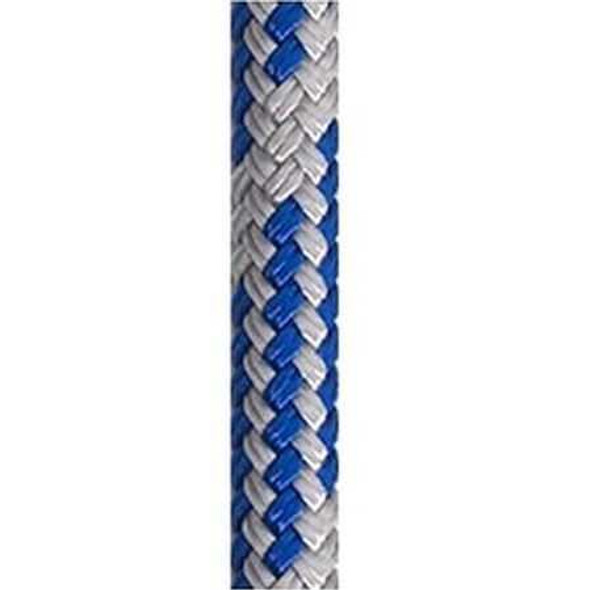
6mm Robline Admiral 5000 Line
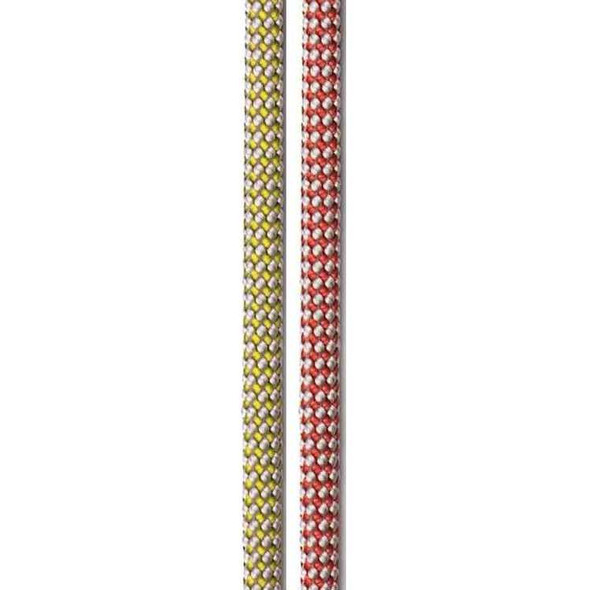
6mm Robline Dinghy Control Line
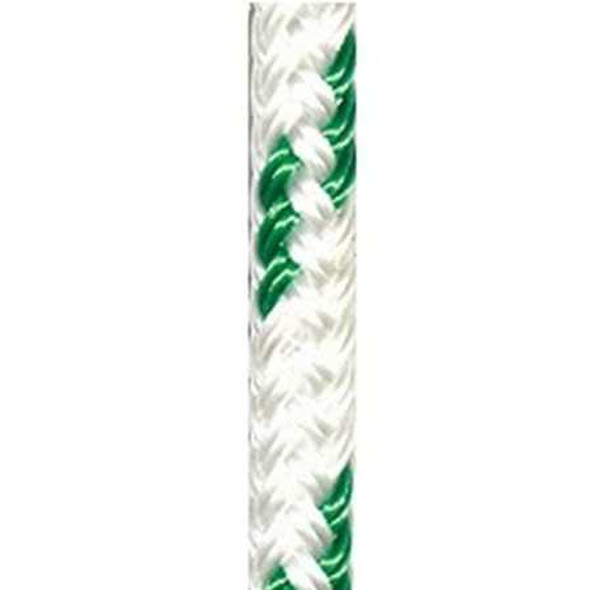
6mm Robline Orion 300 Line
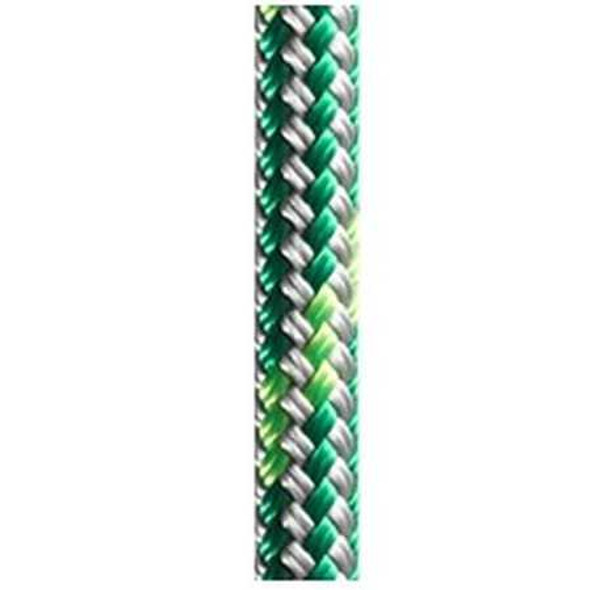
8mm Robline Admiral 5000 Line

10mm Robline Admiral 5000 Line
- Total: items /
- Add all to cart
Adding your products to cart
Halyard recommendations, finding the right diameter.
If you are replacing an existing line, the easiest way to determine what diameter you need is to match what you already have. This can be done with a caliper or by close estimation with a tape measure. If you've previously used a 7mm halyard and it has performed well, another 7mm line is likely a great choice. In most applications, there is some flexibility in the exact diameter that can be used. Most blocks, for example, have an 'ideal' diameter (ie, the line diameter that runs most effectively though the block's sheave) but also have a range so that you can run a slightly thinner or slightly thicker line. If you have a halyard that is getting hung up in your rig, stepping down 1-2mm might help the halyard run more efficiently. If you have a larger boat or rig and want to run a thinner halyard, consider a double braid line that features a Dyneema or spectra core for strength.
Line Diameter Conversion
1mm = 3/64 inch | 2mm = 5/64 inch | 3mm = 1/8 inch
4mm = 5/32 inch | 5mm = 3/16 inch | 6mm = 1/4 inch
7mm = 9/32 inch | 8mm = 5/16 inch | 9mm = 3/8 inch
10mm = 25/64 in | 11mm = 7/16 in | 12mm = 1/2 in
Double Braid vs Single Braid
Two terms you will often see in line descriptions are 'double braid' and 'single braid', which refer to the way the line is constructed. At the most basic level, a double braid line has a cover and a core whereas a single braid does not, but there are other important distinctions to consider when making a line selection.
Single Braids are made up of either 8 or 12 strands that are braided into a circular pattern, half clockwise and half counter clockwise. This produces a line that is supple, absorbs twists, and tends not to kink. There are two types of single braid lines: performance single braids and polyester/blended single braids. Performance single braids are made from fibers with very low stretch and designed to handle extreme loads - think Dyneema, Spectra, or Vectran. Polyester/blended single braids, sometimes called hollow braid, are soft and easy to grip, built for sheets and hand-adjusted control lines. These are less common than performance single braid lines but recommended in a few specific applications.
Double Braids , sometimes called braid on braid, have a braided core within a braided outer jacket or cover. This creates a strong, durable, smooth-running line that is easy to handle. Double braids are used for the vast majority of all running rigging on sailboats including sheets, halyards and control lines for both cruising or racing. There are two types to consider: polyester double braids and high-tech double braids. Polyester double braids, found most commonly on recreational and cruising sailboats, have a polyester cover with polyester core. These are low maintenance, affordable, and long-lasting, while offering relatively low stretch and high working loads. For additional strength and minimal stretch, consider high-tech double braids. These lines typically feature a Dyneema or Spectra core (non-stretch) inside a polyester or polyester/dyneema blend cover for additional durability. They are more expensive but often the go to choice for high performance racing boats.
For halyards, we typically recommend a line with double braid construction because they hold their shape well under load and when cleated or in a clutch.
Whipping & Splicing
Looking to clean up the end of your line or need to add a splice to your rig? Visit our Whipping & Splicing page for a full selection of whipping twine, fids, splicing needles, and complete splicing kits. Perfect for the DIY sailor looking to further optimize their rigging.
Subscribe To Our Newsletter
Sign up for our newsletter to receive exclusive discounts, new product announcements, and upcoming sales.
Home > Resources > Halyards, Sheets, and Lines: A Guide to Choosing and Maintaining Your Sailboat Rigging
Halyards, Sheets, and Lines: A Guide to Choosing and Maintaining Your Sailboat Rigging
11 May 2023
Ask Precision Sails , Hardware , Maintenance , Technical

How to Choose the Right Halyard/Sheet
When choosing a halyard for your sailboat, several factors come into play. These include the weight of the sail, the type of sail, the sailboat’s size, and the expected wind conditions. You should also consider the halyard’s stretch, which affects sail shape and performance. It is essential to choose a halyard that matches the load the sail will have on the line. Low-stretch halyards are ideal for racing and performance sailing, where every fraction of a knot counts.
Some Things to Consider when Choosing a Halyard or Sheet Include:
- Material: The material you choose for your line can affect its strength, durability, and stretch resistance.
- Diameter: The diameter of your halyard or sheet should be appropriate for the load the sail will apply to it and the size of your boat.
- Length: The length of your halyard or sheet should allow you to run your lines wherever they are needed, plus some extra for you to trim and tie off with.
- Attachment: The type of attachment you choose for your halyard or sheet can change depending on how you run your sheets and how the head of your sail is configured.
- Review Your Options: Making a decision about lines can be daunting, luckily Precision Sails has made it easy for you to pick your halyard or sheets by simplifying the process into two groups and pre-selecting the diameter, length, and attachment for your boat and line.
Here is a Quick Guide to Explain Material Choice:
The Precision Cruising series employs high-quality polyester lines, which are a good all-around option for starting and performing well. Polyester halyards and sheets are the most common and suitable for most sizes of sailboats, but they do stretch more than other lines like dyneema, spectra, or stirotex, which can affect sail shape and performance.
To address this, the Precision Performance series focuses on using stronger and stretch-resistant inner cores, making them ideal for racing sailboats that require high precision and tight tolerances. These lines are made of stirotex, which you may recognize by the name of spectra or dyneema. Stirotex is a chemically identical variation. The parent compound in these high-tension lines is HMPE. These lines are the strongest and least stretchy, making them the top choice for high-performance racing sailboats.
How to Maintain Your Halyards, Sheets, and Lines
Proper maintenance of your halyards is crucial for their longevity and reliability. Some tips for maintaining your halyards include:
Maintenance Checklist
- Regular inspection: Check your lines regularly for signs of wear, fraying, or damage.
- Cleaning: Clean your halyards and sheets periodically with soap and water to remove dirt and salt buildup.
- Lubrication: Lubricate your halyards and sheets with a silicone spray or dry lubricant to reduce friction and wear.
- Storage: When not in use, store your lines coiled neatly and out of direct sunlight if you can.
Signs of Wear – How to Inspect Your Lines
Lines that show obvious signs of deterioration must be discarded and replaced immediately. One of the most apparent and hazardous signs of wear on a line is a cut or damaged sheath that exposes the core. In such cases, it is important to retire the line immediately to prevent any further damage or potential failures.
Other signs may include hardness around the sheath or fuzziness. These signs may be particularly evident near the connection points or any areas of high friction. It’s also important to pay attention to any changes in the handling or feel of the line, as this may indicate internal damage or other issues that require attention.
A way to protect your investment is proper care and cleaning and avoiding the use of harsh chemicals or high-pressure washers, which can damage the fibers. This can be done by soaking them in a bucket of warm water with mild soap or detergent, then rinsing thoroughly and allowing them to air dry. This helps to remove any salt, dirt, or grime that may have accumulated, which can cause premature wear and tear if left unchecked.
A way to visualize this is to envision dirt particles getting trapped between the fibers of the line and causing small tears in the weave. When the line is put under tension, these dirt particles act like miniature saw blades, gradually weakening the line over time and potentially leading to catastrophic failures. Therefore, regular cleaning and maintenance of your lines, including halyards and sheets, is essential to ensure their longevity and reliability and to avoid any dangerous situations while out on the water.
Inspecting Your Lines for Damage
Pro tip: Usage level and proper care is a more important indicator than age
Let’s dispel some common misconceptions about when to retire a sailboat line. For example, some sailors may retire a line based solely on its age, rather than its condition. We want to stress the importance of inspecting lines regularly and retiring them when signs of wear or damage are detected, regardless of their age. Here’s a helpful checklist so you know what to look for on your lines.
Inspection Checklist
- Check for visual signs of wear and tear, such as fraying or abrasions, which can weaken the line and compromise its strength. Be sure to examine the line thoroughly, paying particular attention to any areas of high friction or wear.
- Run your hands along the length of the line, feeling for any hard or soft spots, which can indicate internal damage or wear. If you detect any abnormalities, consider retiring the line or seeking professional advice.
- Look for any signs of UV damage, which can cause the line to degrade over time. This is particularly important for lines that are exposed to sunlight for extended periods.
- Check the diameter of the line, ensuring that it matches the manufacturer’s specifications. Any significant deviations may indicate that the line has been stretched or otherwise damaged.
- Examine the connection points, including splices and knots, ensuring that they are secure and free from any signs of wear or damage.
To recap, lines, halyards, and sheets are an essential component of any sailing vessel, and choosing the right halyard for your boat is a necessary part of outfitting your vessel. Regular maintenance and proper care of your halyards can ensure their longevity and reliability. We hope this article has provided valuable insights into halyards, sheets, and lines, though we understand that it may seem like a lot of information.
If you feel overwhelmed by the amount of information, don’t worry, we have simplified the process of finding the right line for your boat. Simply fill out a form , and we will send you the best fit and our professional opinion based on the type of sailing you plan on doing. If you have any questions, comments, or wish to order lines from our sail consultants, please don’t hesitate to contact us.
FAQ’s
Q: What is a sailboat halyard?
A: Halyards are ropes or lines used to hoist sails, flags, and other equipment on a boat.
Q: What is a sailboat sheet?
A: A sailboat sheet is a line that is attached to the lower corner of a sail and used to control its position relative to the wind. The sheet is usually led through a block or a series of blocks, which allow the sailor to adjust the sail’s angle and trim it for maximum efficiency. In addition to controlling the sail’s position, the sheet also helps to control the sail’s shape and tension, which can affect the boat’s speed and handling.
Q: Can different types of materials be used to make halyards, sheets, and lines?
A: Yes, lines can be made of various materials such as polyester, nylon, stirotex, and dyneema. Each material has its own strengths and weaknesses, and the choice of material depends on the type of sailing and personal preference.
Q: How do I determine the length of halyard I need for my sailboat?
A: It’s important to consult with a sail consultant or experienced sailor to ensure you get the correct length. The length of halyard you need will depend on the height of your mast, the type and size of the sail you will be using, and where you plan on trimming your sails. Calculating the length is more complex than simply taking a guess, not to worry though, we have made it easy. Give us a call or fill out our form to let our system crunch the numbers for you.
Q: How do I know if my halyard or sheets are due for replacement?
A: Look for signs of wear and tear such as fraying, kinking, or stretching. If the line feels stiff or brittle, it may be time to replace it. Additionally, if you notice any damage to the sheave or winch, this may also indicate the need for a replacement. See the checklist above for detailed instructions.
Q: Are there any safety precautions I should take when using halyards and sheets?
A: Yes, it’s important to properly understand how to use a winch and don’t wrap the rope around your arm or fingers. Always be aware of your surroundings and avoid getting entangled in halyards or other lines. It’s also recommended to have a backup halyard in case of failure or emergency situations.
Q: How can halyards affect the performance of a sailboat?
A: The type of halyard used can have an impact on the performance of the sailboat. For instance, a stretchy halyard may cause the sail to lose its shape by releasing the tension on the sail over time, while a stretch-resistant halyard can help the sail maintain its shape in strong winds.
Q: Is it possible to splice or repair a damaged halyard or sheet?
A: It is possible to splice or repair a damaged halyard, depending on the extent of the damage and the material of the halyard. However, it’s essential to have the repair done by a professional or experienced sailor to ensure the halyard’s continued reliability and safety.
Q: How often should I replace my lines?
A: The lifespan of halyards and sheets can vary depending on factors such as usage, exposure to weather, and material. It’s recommended to regularly inspect your lines for wear and tear and replace them as needed. Condition is a much stronger indicator than age. Assuming light use and good condition, some materials like Stirotex have a longer lifespan, other materials may need to be replaced more often. In general, halyards and sheets should be replaced every 3-5 years for optimal safety and efficiency.
Related Posts

Full Battens vs Partial Battens vs 2 Full plus 2 Partial Battens
Full Battens VS Partial Battens At
Precision Sails we are asked every day during our customer quote consultation “Should I choose Full Battens or Partial Battens for my new mainsail?” Whether you are cruising or racing you will need to examine the pros and cons of adding full battens to your main sail.Positive Aspects of Full […]

My Need for Cruising Speed Demands a Great Suit of Sails
My Need for Cruising Speed Demands a Great Suit of SailsI like to sail fast mostly in the heavy winds that Lake Ontario throws.

How to Fold a Sail (Mainsail or Headsail) For safe Storage
Knowing how to fold a sail correctly will make your sails last longer and make them easier to set. Replacement sails are an investment and folding them properly is important to their longevity.
" * " indicates required fields

What Type Of Line Is Best For Halyards
- July 14, 2023
Table of Contents
Sail shape plays a crucial role in the performance of a sailboat, and one of the key factors affecting sail shape is the halyard line. This article explores the importance of selecting the best line for for halyards on a sailboat and delves into how halyard stretch can impact sail shape and overall performance. We will discuss various types of lines suitable for sailboat halyards and provide insights into how their characteristics affect sail shape. Understanding these dynamics will help sailors make informed decisions when choosing halyard lines for their sailboats.
Popular Types of Lines for Sailboat Halyards
The durable and low-stretch properties of polyester make it a popular choice for halyard lines. Its resistance to UV rays and grip in winches and cleats make it easy to handle, and it is available in various diameters and strengths to suit different sailboat sizes and applications.
Dyneema/Spectra
High-performance synthetic fibers like Dyneema and Spectra offer exceptional strength-to-weight ratios and minimal stretch. These lines are ideal for halyards due to their low stretch properties, UV resistance, and abrasion resistance. Although they may be more expensive than polyester, their superior performance makes them attractive options for performance-oriented sailboats.
Technora is another high-performance fiber known for its strength and heat resistance. It shares similar properties to Dyneema and Spectra but offers enhanced heat resistance. Technora halyards are commonly used in racing applications where high loads and extreme conditions are expected.
Vectran is a liquid crystal polymer fiber with high strength and low stretch characteristics. It is resistant to UV radiation and abrasion, making it suitable for halyards. Vectran lines provide good handling and are often favored for performance-oriented sailboats.
The Impact of Using Low-Quality Line For Halyards
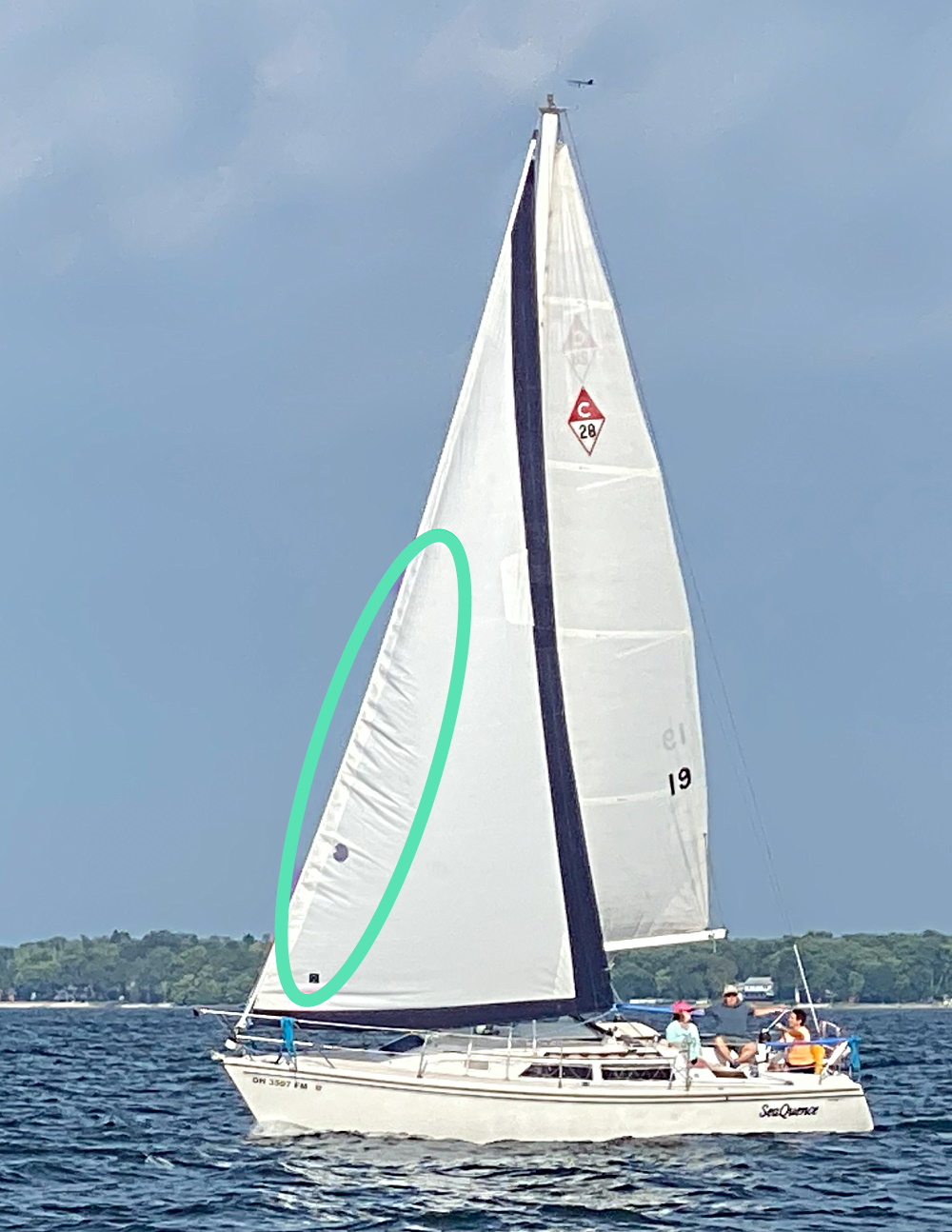
Halyard stretch allows the sail’s luff to move upward, resulting in luff sag or belly. This sagging disrupts the designed sail shape and reduces its efficiency. Properly tensioned halyards are crucial for maintaining the desired curvature of the sail’s leading edge, ensuring optimal performance.
Draft Position
Halyard stretch can shift the position of the sail’s draft, which is the maximum curvature or belly of the sail. As the halyard stretches, the tension on the luff decreases, causing the draft to move higher on the sail. This change in draft position can affect the balance and performance of the sail, leading to reduced speed and pointing ability.
Halyard tension plays a significant role in controlling the amount of twist in the sail. Stretching halyards can reduce tension on the luff, leading to excessive twist in the upper part of the sail. Excessive twist can result in power loss, reduced control, and an unbalanced sail plan.
Sail Control and Trim
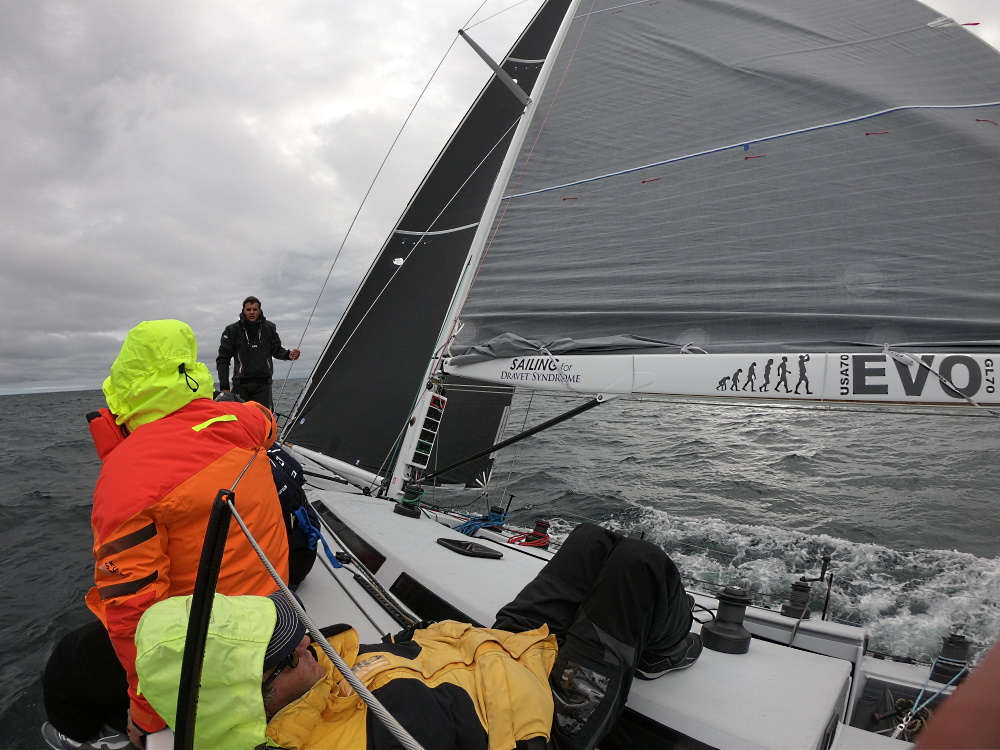
Selecting the Best Line for Halyards
Considerations.
When choosing halyard lines, factors such as load-bearing capacity, low stretch, durability, handling, and weight must be taken into account. The line should have sufficient strength to handle the expected loads without excessive stretching or risk of failure. Low-stretch lines help maintain proper sail shape, while durability ensures longevity and resistance to UV radiation, saltwater, and abrasion.
Recommendations
Lines made of polyester, Dyneema, Spectra, Technora, or Vectran are commonly used for sailboat halyards. Polyester lines offer good all-around performance and affordability. High-performance fibers like Dyneema, Spectra, Technora, and Vectran provide excellent strength, low stretch, and increased performance, albeit at a higher cost. The choice depends on the specific requirements, sailing style, and budget of the sailor.
Sailboat Halyard Line Diameter Guide
The following is a general guideline for sailboat lengths and the associated halyard line diameter:
- Sailboat Length: Up to 20 feet – Halyard Line Diameter: 3/16″ to 5/16″ (4-8 mm)
- Sailboat Length: 20-25 feet – Halyard Line Diameter: 5/16″ to 3/8″ (8-10 mm)
- Sailboat Length: 25-30 feet – Halyard Line Diameter: 3/8″ to 7/16″ (10-11 mm)
- Sailboat Length: 30-35 feet – Halyard Line Diameter: 7/16″ to 1/2″ (11-13 mm)
- Sailboat Length: 35-40 feet – Halyard Line Diameter: 1/2″ to 9/16″ (13-14 mm)
- Sailboat Length: 40-45 feet – Halyard Line Diameter: 9/16″ to 5/8″ (14-16 mm)
- Sailboat Length: 45-50 feet – Halyard Line Diameter: 5/8″ to 3/4″ (16-19 mm)
- Sailboat Length: 50-60 feet – Halyard Line Diameter: 3/4″ to 7/8″ (19-22 mm)
- Sailboat Length: 60+ feet – Halyard Line Diameter: 7/8″ and above (22 mm and above)
Best Line To Purchase For Halyards

New England Ropes 5/16″ (8mm) Endura Braid

New England Ropes 3/8in (10mm) Endura Braid

New England Ropes 1/2in (11mm)

New England Ropes 1/2in (12mm) Sta-Set

New England Ropes 9/16in (14mm) Sta-Set
Please note that these recommendations are approximate and can vary depending on factors such as boat design, anticipated loads, sailing conditions, and personal preferences. It’s important to consult with the sailboat manufacturer, riggers, or experienced sailors to determine the specific halyard line diameter recommendations for your sailboat based on its specifications and intended use.
Seeking Expert Advice
Consulting with sailmakers, riggers, or experienced sailors can provide valuable insights into selecting the right line for halyards. These professionals can offer tailored recommendations based on the sailboat’s specifications, intended use, and sailing conditions.
Choosing the right line for sailboat halyards is crucial to ensure optimal sail shape and performance. Halyard stretch can significantly impact sail shape, leading to reduced efficiency, power loss, and compromised sailing capabilities. Polyester, Dyneema, Spectra, Technora, and Vectran are popular choices for halyard lines, each offering distinct advantages in terms of strength, stretch resistance, durability, and handling.
Understanding the characteristics of these lines and their effects on sail shape empowers sailors to make informed decisions when selecting halyard lines for their sailboats. Regular maintenance, including checking and adjusting halyard tension, is essential to minimize the impact of halyard stretch and maintain proper sail shape. Seeking advice from professionals in the sailing community can further enhance the decision-making process.
By choosing the right line for sailboat halyards, sailors can optimize sail performance, maintain efficient sail trim, and enjoy a smoother and more enjoyable sailing experience.
The Sailor’s Marketplace for Sailboats and Sails.
Sell Your Sailboat
Sailboats for sale.
- New Sailboats
- Used Sailboats
- Cruising Sailboats
- Racing Sailboats
Sell Your Sails
Sails for sail, sail manufacturers.
- North Sails
- Quantum Sails
- Doyle Sails
- UK Sailmakers
Sailing Reviews
- Sailing Line
- Safety Equipment
- Sailing Accesories
As an Amazon Associate SailTrader earns from qualifying purchases.
This website uses cookies to ensure you get the best experience possible.
Sailboat Parts Explained: Illustrated Guide (with Diagrams)
When you first get into sailing, there are a lot of sailboat parts to learn. Scouting for a good guide to all the parts, I couldn't find any, so I wrote one myself.
Below, I'll go over each different sailboat part. And I mean each and every one of them. I'll walk you through them one by one, and explain each part's function. I've also made sure to add good illustrations and clear diagrams.
This article is a great reference for beginners and experienced sailors alike. It's a great starting point, but also a great reference manual. Let's kick off with a quick general overview of the different sailboat parts.
General Overview
The different segments
You can divide up a sailboat in four general segments. These segments are arbitrary (I made them up) but it will help us to understand the parts more quickly. Some are super straightforward and some have a bit more ninja names.
Something like that. You can see the different segments highlighted in this diagram below:
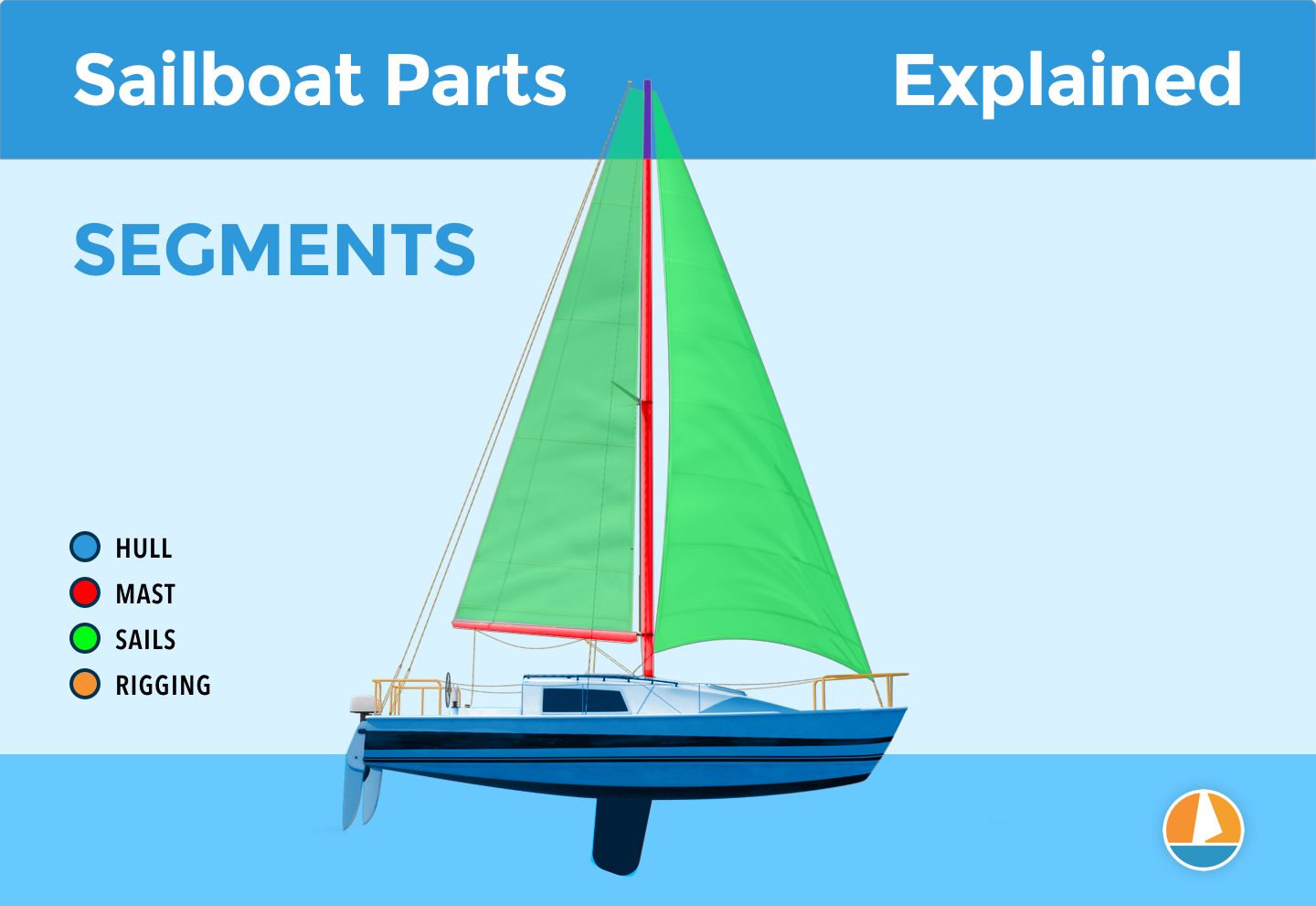
The hull is what most people would consider 'the boat'. It's the part that provides buoyancy and carries everything else: sails, masts, rigging, and so on. Without the hull, there would be no boat. The hull can be divided into different parts: deck, keel, cabin, waterline, bilge, bow, stern, rudder, and many more.
I'll show you those specific parts later on. First, let's move on to the mast.

Sailboats Explained
The mast is the long, standing pole holding the sails. It is typically placed just off-center of a sailboat (a little bit to the front) and gives the sailboat its characteristic shape. The mast is crucial for any sailboat: without a mast, any sailboat would become just a regular boat.
I think this segment speaks mostly for itself. Most modern sailboats you see will have two sails up, but they can carry a variety of other specialty sails. And there are all kinds of sail plans out there, which determine the amount and shape of sails that are used.
The Rigging
This is probably the most complex category of all of them.
Rigging is the means with which the sails are attached to the mast. The rigging consists of all kinds of lines, cables, spars, and hardware. It's the segment with the most different parts.
The most important parts
If you learn anything from this article, here are the most important parts of any sailboat. You will find all of these parts in some shape or form on almost any sailboat.

Okay, we now have a good starting point and a good basic understanding of the different sailboat parts. It's time for the good stuff. We're going to dive into each segment in detail.
Below, I'll go over them one by one, pointing out its different parts on a diagram, listing them with a brief explanation, and showing you examples as well.
After reading this article, you'll recognize every single sailboat part and know them by name. And if you forget one, you're free to look it up in this guide.
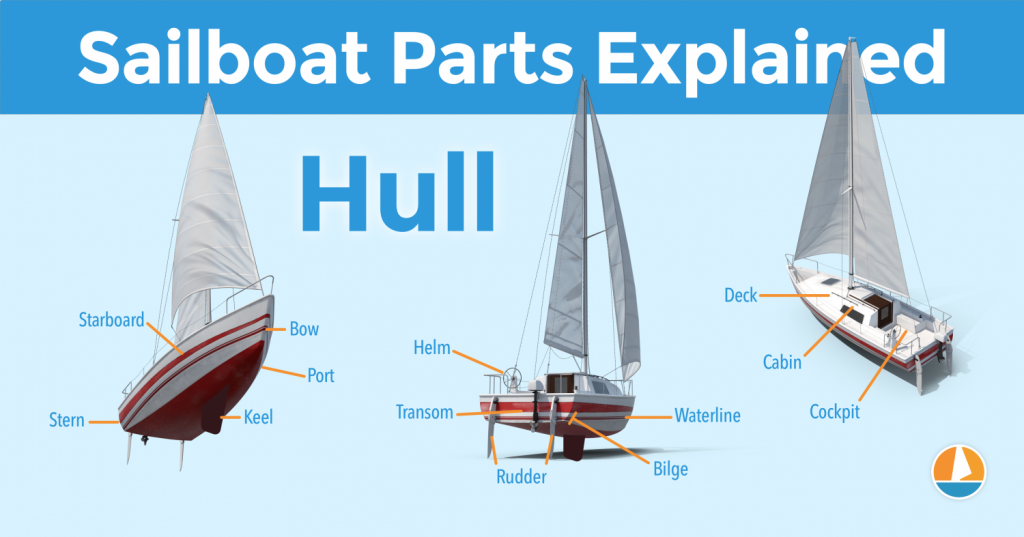
On this page:
The hull is the heart of the boat. It's what carries everything: the mast, the sails, the rigging, the passengers. The hull is what provides the sailboat with its buoyancy, allowing it to stay afloat.
Sailboats mostly use displacement hulls, which is a shape that displaces water when moving through it. They are generally very round and use buoyancy to support its own weight. These two characteristics make sure it is a smooth ride.
There are different hull shapes that work and handle differently. If you want to learn more about them, here's the Illustrated Guide to Boat Hull Types (with 11 Examples ). But for now, all we need to know is that the hull is the rounded, floating part of any sailboat.
Instead of simply calling the different sides of a hull front, back, left and right , we use different names in sailing. Let's take a look at them.
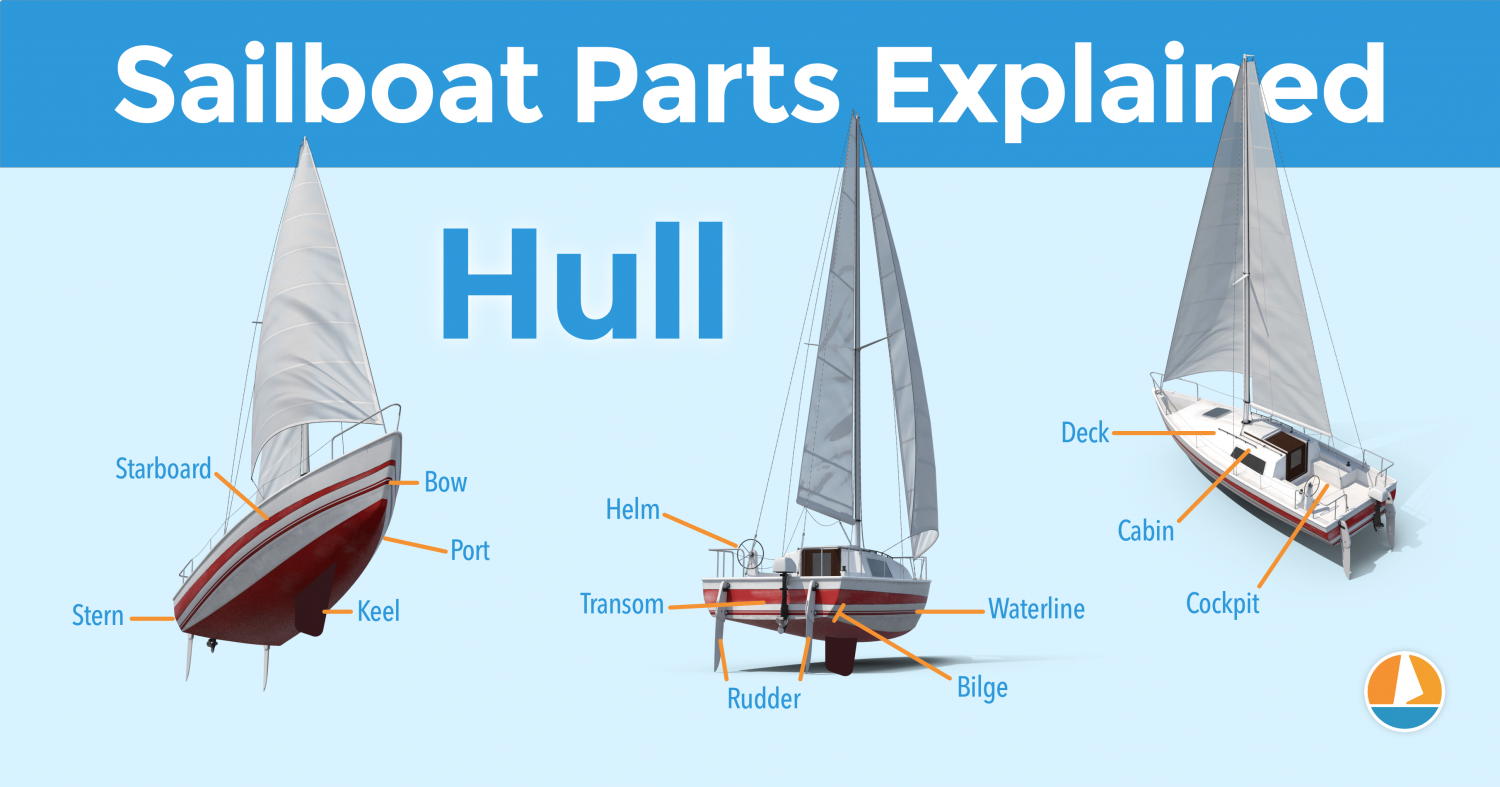
The bow is the front part of the hull. It's simply the nautical word for 'front'. It's the pointy bit that cuts through the water. The shape of the bow determines partially how the boat handles.
The stern is the back part of the hull. It's simply the nautical word for 'back'. The shape of the stern partially determines the stability and speed of the boat. With motorboats, the stern lies deep inside the water, and the hull is flatter aft. Aft also means back. This allows it to plane, increasing the hull speed. For sailboats, stability is much more important, so the hull is rounded throughout, increasing its buoyancy and hydrodynamic properties.
The transom is the backplate of the boat's hull. It's the most aft (rear) part of the boat.
Port is the left side of a sailboat.
Starboard is the right side of a sailboat
The bilges are the part where the bottom and the sides of the hull meet. On sailboats, these are typically very round, which helps with hydrodynamics. On powerboats, they tend to have an angle.
The waterline is the point where the boat's hull meets the water. Generally, boat owners paint the waterline and use antifouling paint below it, to protect it from marine growth.
The deck is the top part of the boat's hull. In a way, it's the cap of the boat, and it holds the deck hardware and rigging.
Displacement hulls are very round and smooth, which makes them very efficient and comfortable. But it also makes them very easy to capsize: think of a canoe, for example.
The keel is a large fin that offsets the tendency to capsize by providing counterbalance. Typically, the keel carries ballast in the tip, creating a counterweight to the wind's force on the sails.
The rudder is the horizontal plate at the back of the boat that is used to steer by setting a course and maintaining it. It is connected to the helm or tiller.
Tiller or Helm
- The helm is simply the nautical term for the wheel.
- The tiller is simply the nautical term for the steering stick.
The tiller or helm is attached to the rudder and is used to steer the boat. Most smaller sailboats (below 30') have a tiller, most larger sailboats use a helm. Large ocean-going vessels tend to have two helms.
The cockpit is the recessed part in the deck where the helmsman sits or stands. It tends to have some benches. It houses the outside navigation and systems interfaces, like the compass, chartplotter, and so on. It also houses the mainsheet traveler and winches for the jib. Most boats are set up so that the entire vessel can be operated from the cockpit (hence the name). More on those different parts later.
Most larger boats have some sort of roofed part, which is called the cabin. The cabin is used as a shelter, and on cruising sailboats you'll find the galley for cooking, a bed, bath room, and so on.
The mast is the pole on a sailboat that holds the sails. Sailboats can have one or multiple masts, depending on the mast configuration. Most sailboats have only one or two masts. Three masts or more is less common.
The boom is the horizontal pole on the mast, that holds the mainsail in place.
The sails seem simple, but actually consist of many moving parts. The parts I list below work for most modern sailboats - I mean 90% of them. However, there are all sorts of specialty sails that are not included here, to keep things concise.
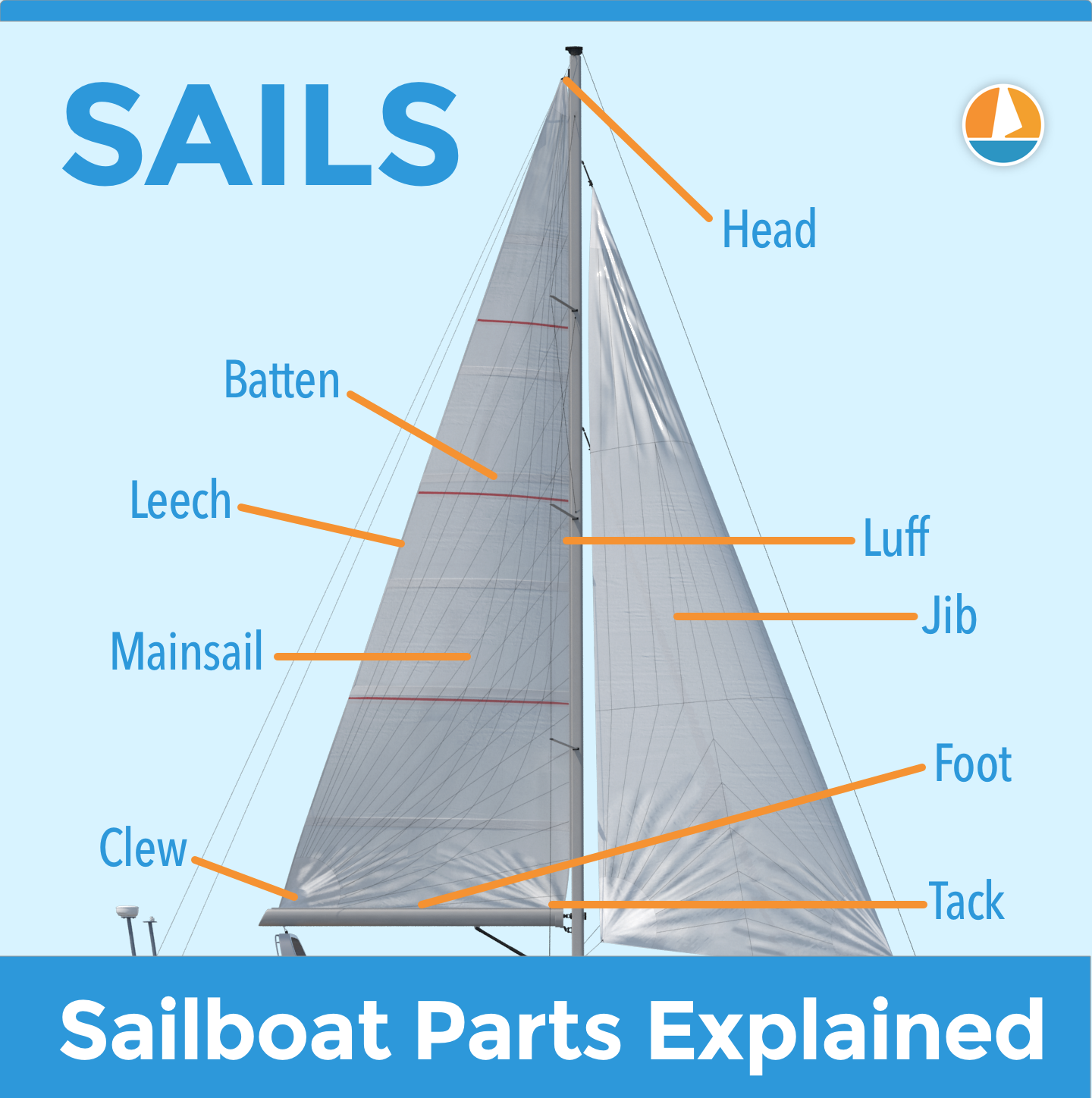
The mainsail is the largest sail on the largest mast. Most sailboats use a sloop rigging (just one mast with one bermuda mainsail). In that case, the main is easy to recognize. With other rig types, it gets more difficult, since there can be multiple tall masts and large sails.
If you want to take a look at the different sail plans and rig types that are out there, I suggest reading my previous guide on how to recognize any sailboat here (opens in new tab).
Sail sides:
- Leech - Leech is the name for the back side of the sail, running from the top to the bottom.
- Luff - Luff is the name for the front side of the sail, running from the top to the bottom.
- Foot - Foot is the name for the lower side of the sail, where it meets the boom.
Sail corners:
- Clew - The clew is the lower aft (back) corner of the mainsail, where the leech is connected to the foot. The clew is attached to the boom.
- Tack - The tack is the lower front corner of the mainsail
- Head - The head is the top corner of the mainsail
Battens are horizontal sail reinforcers that flatten and stiffen the sail.
Telltales are small strings that show you whether your sail trim is correct. You'll find telltales on both your jib and mainsail.
The jib is the standard sized headsail on a Bermuda Sloop rig (which is the sail plan most modern sailboats use).
As I mentioned: there are all kinds, types, and shapes of sails. For an overview of the most common sail types, check out my Guide on Sail Types here (with photos).
The rigging is what is used to attach your sails and mast to your boat. Rigging, in other words, mostly consists of all kinds of lines. Lines are just another word for ropes. Come to think of it, sailors really find all kinds of ways to complicate the word rope ...
Two types of rigging
There are two types of rigging: running and standing rigging. The difference between the two is very simple.
- The running rigging is the rigging on a sailboat that's used to operate the sails. For example, the halyard, which is used to lower and heave the mainsail.
- The standing rigging is the rigging that is used to support the mast and sail plan.
Standing Rigging
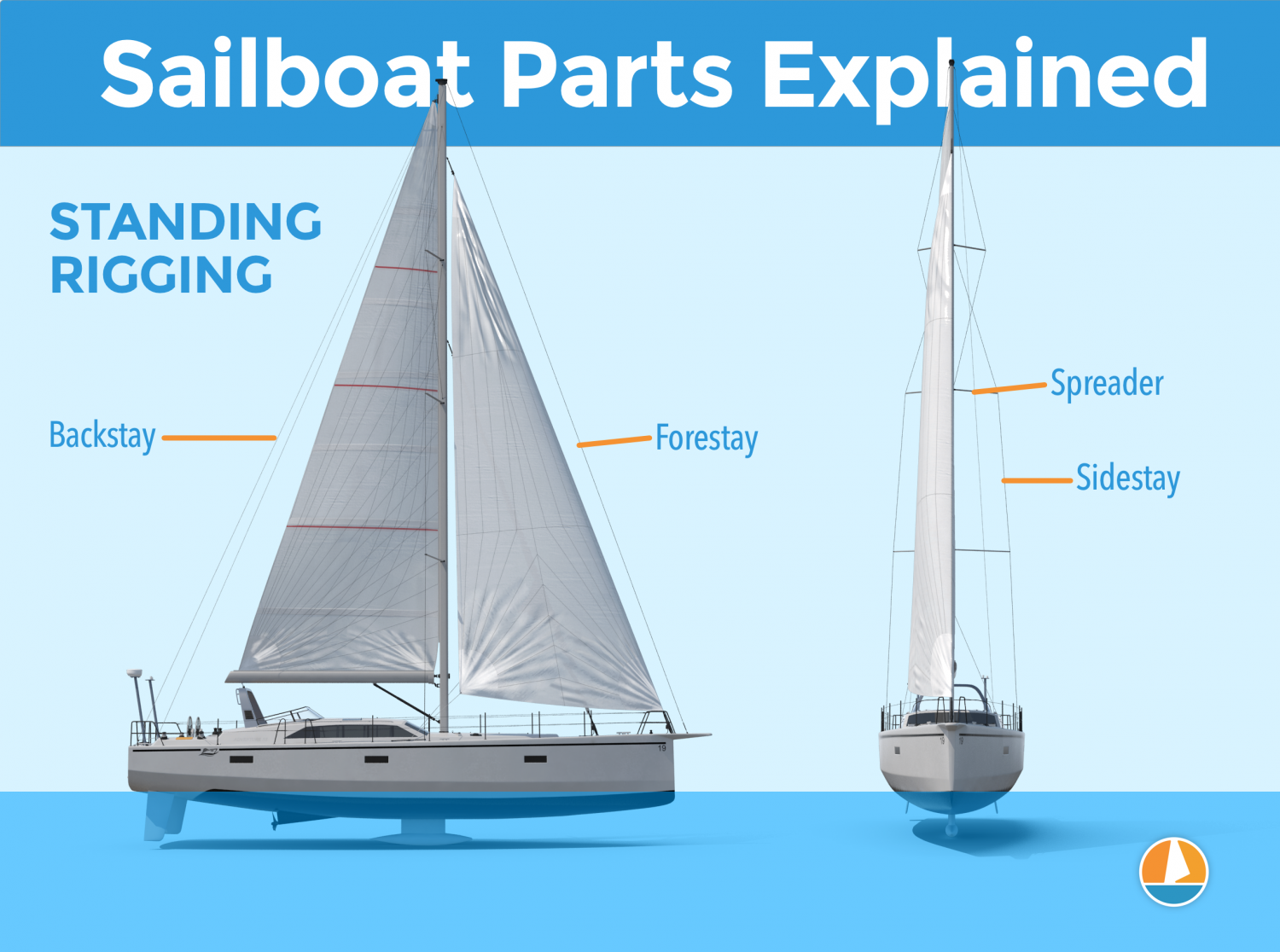
Here are the different parts that belong to the standing rigging:
- Forestay or Headstay - Line or cable that supports the mast and is attached to the bow of the boat. This is often a steel cable.
- Backstay - Line or cable that supports the mast and is attached to the stern of the boat. This is often a steel cable.
- Sidestay or Shroud - Line or cable that supports the mast from the sides of the boat. Most sailboats use at least two sidestays (one on each side).
- Spreader - The sidestays are spaced to steer clear from the mast using spreaders.
Running Rigging: different words for rope
Ropes play a big part in sailing, and especially in control over the sails. In sailboat jargon, we call ropes 'lines'. But there are some lines with a specific function that have a different name. I think this makes it easier to communicate with your crew: you don't have to define which line you mean. Instead, you simply shout 'mainsheet!'. Yeah, that works.
Running rigging consists of the lines, sheets, and hardware that are used to control, raise, lower, shape and manipulate the sails on a sailboat. Rigging varies for different rig types, but since most sailboats are use a sloop rig, nearly all sailboats use the following running rigging:
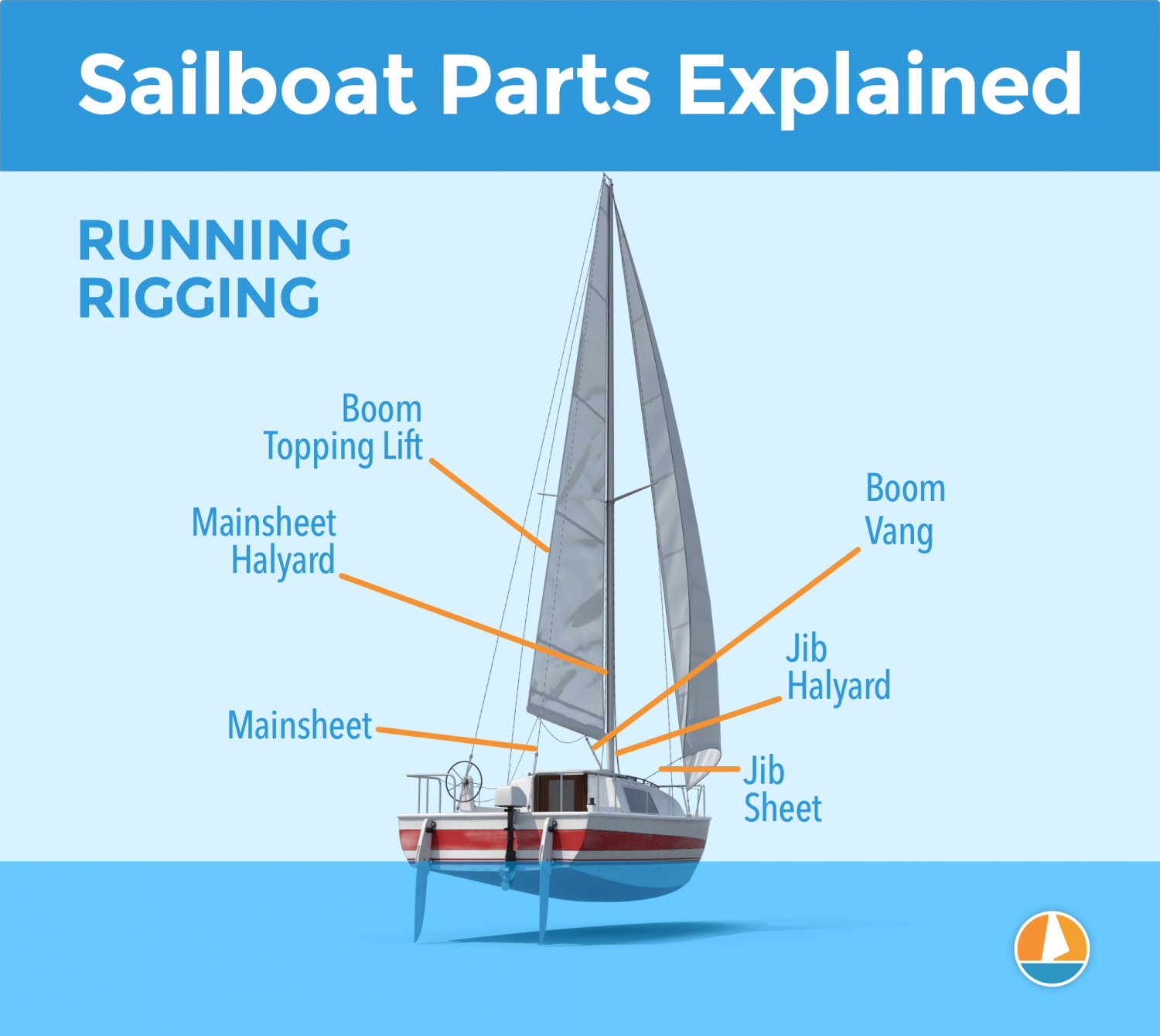
- Halyards -'Halyard' is simply the nautical name for lines or ropes that are used to raise and lower the mainsail. The halyard is attached to the top of the mainsail sheet, or the gaffer, which is a top spar that attaches to the mainsail. You'll find halyards on both the mainsail and jib.
- Sheets - 'Sheet' is simply the nautical term for lines or ropes that are used to set the angle of the sail.
- Mainsheet - The line, or sheet, that is used to set the angle of the mainsail. The mainsheet is attached to the Mainsheet traveler. More on that under hardware.
- Jib Sheet - The jib mostly comes with two sheets: one on each side of the mast. This prevents you from having to loosen your sheet, throwing it around the other side of the mast, and tightening it. The jib sheets are often controlled using winches (more on that under hardware).
- Cleats are small on-deck hooks that can be used to tie down sheets and lines after trimming them.
- Reefing lines - Lines that run through the mainsail, used to put a reef in the main.
- The Boom Topping Lift is a line that is attached to the aft (back) end of the boom and runs to the top of the mast. It supports the boom whenever you take down the mainsail.
- The Boom Vang is a line that places downward tension on the boom.
There are some more tensioning lines, but I'll leave them for now. I could probably do an entire guide on the different sheets on a sailboat. Who knows, perhaps I'll write it.
This is a new segment, that I didn't mention before. It's a bit of an odd duck, so I threw all sorts of stuff into this category. But they are just as important as all the other parts. Your hardware consists of cleats, winches, traveler and so on. If you don't know what all of this means, no worries: neither did I. Below, you'll find a complete overview of the different parts.
Deck Hardware
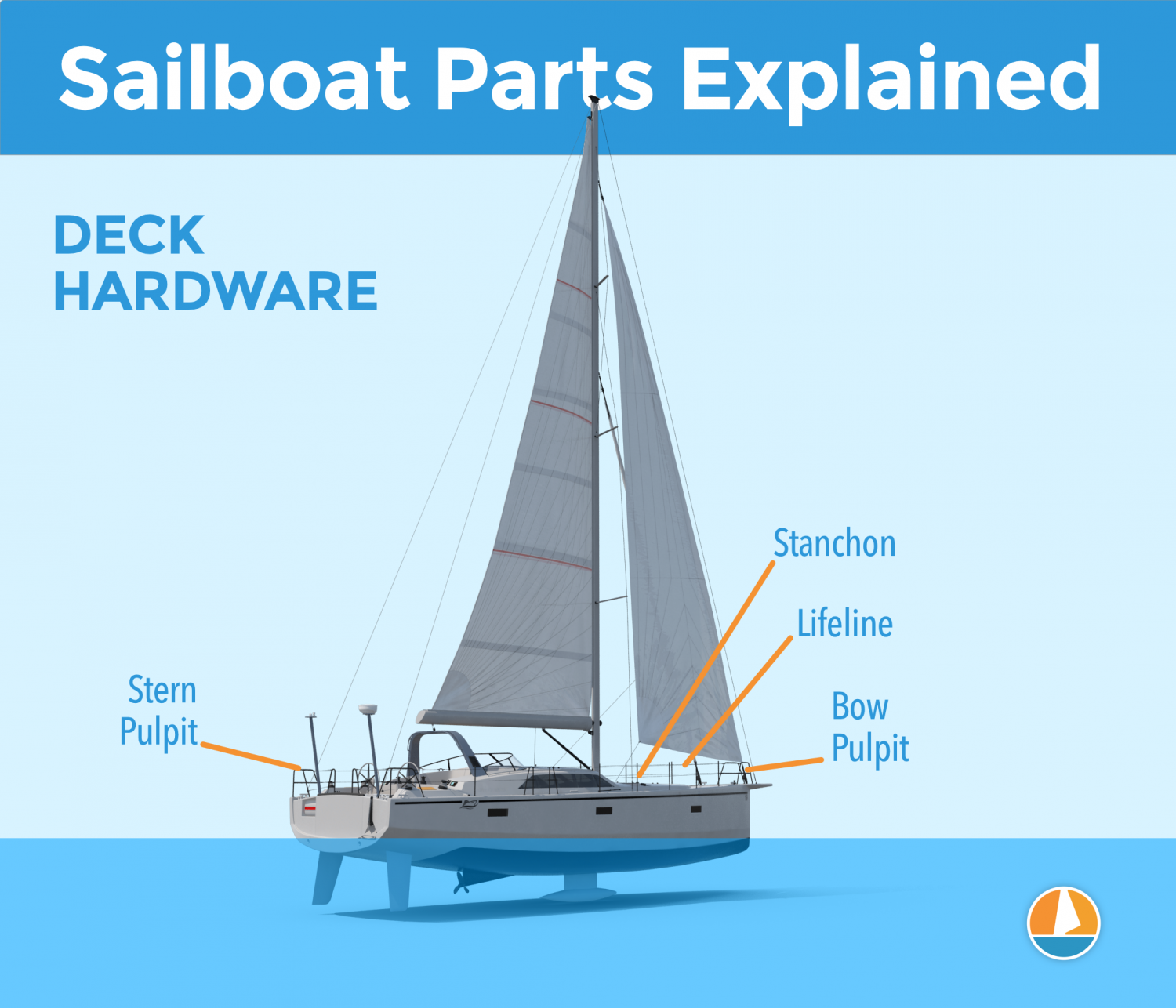
Just a brief mention of the different deck hardware parts:
- Pulpits are fenced platforms on the sailboat's stern and bow, which is why they are called the bow pulpit and stern pulpit here. They typically have a solid steel framing for safety.
- Stanchons are the standing poles supporting the lifeline , which combined for a sort of fencing around the sailboat's deck. On most sailboats, steel and steel cables are used for the stanchons and lifelines.
Mainsheet Traveler
The mainsheet traveler is a rail in the cockpit that is used to control the mainsheet. It helps to lock the mainsheet in place, fixing the mainsails angle to the wind.
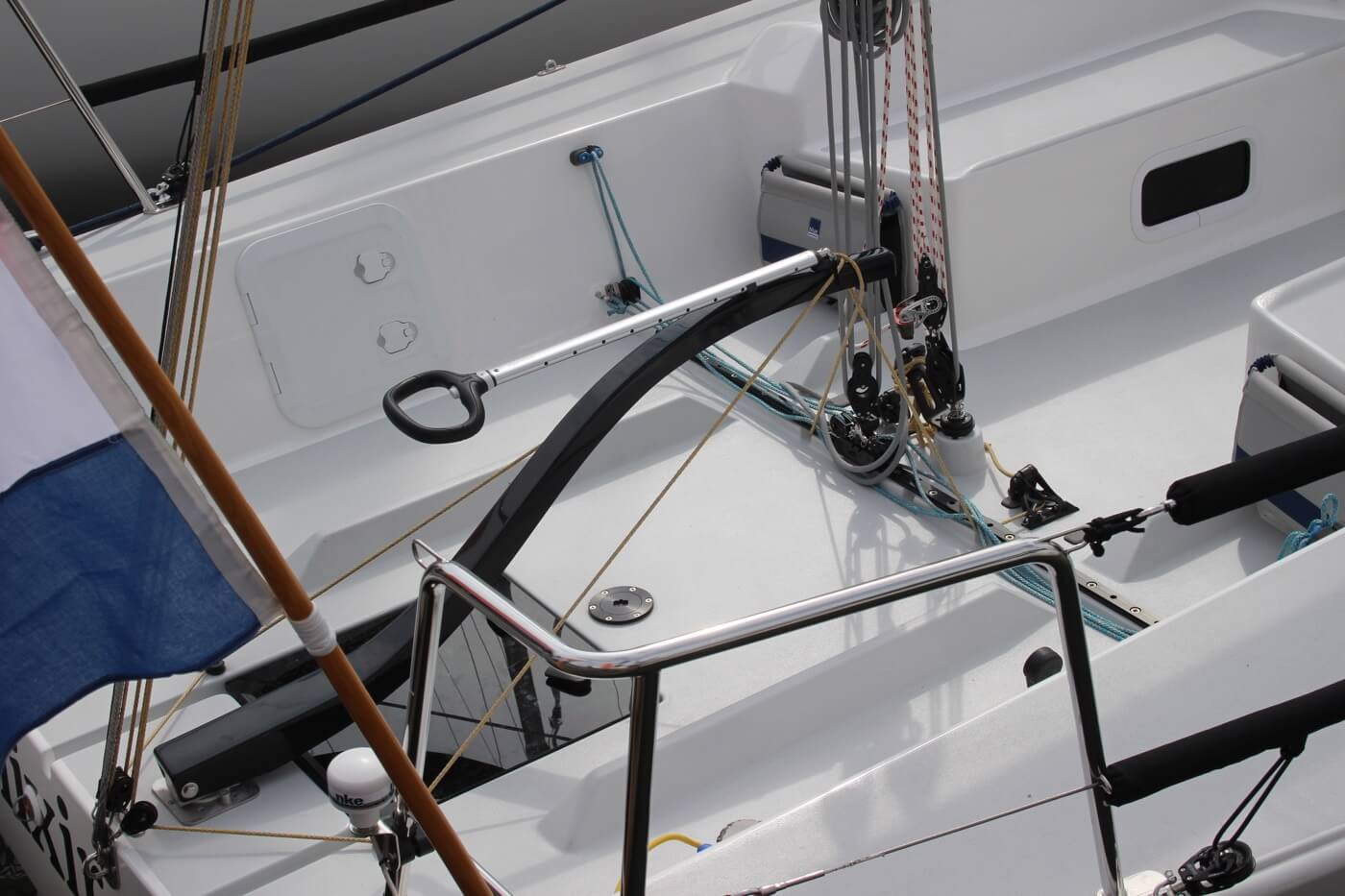
If you're interested in learning more about how to use the mainsheet traveler, Matej has written a great list of tips for using your mainsheet traveler the right way . It's a good starting point for beginners.
Winches are mechanical or electronic spools that are used to easily trim lines and sheets. Most sailboats use winches to control the jib sheets. Modern large sailing yachts use electronic winches for nearly all lines. This makes it incredibly easy to trim your lines.
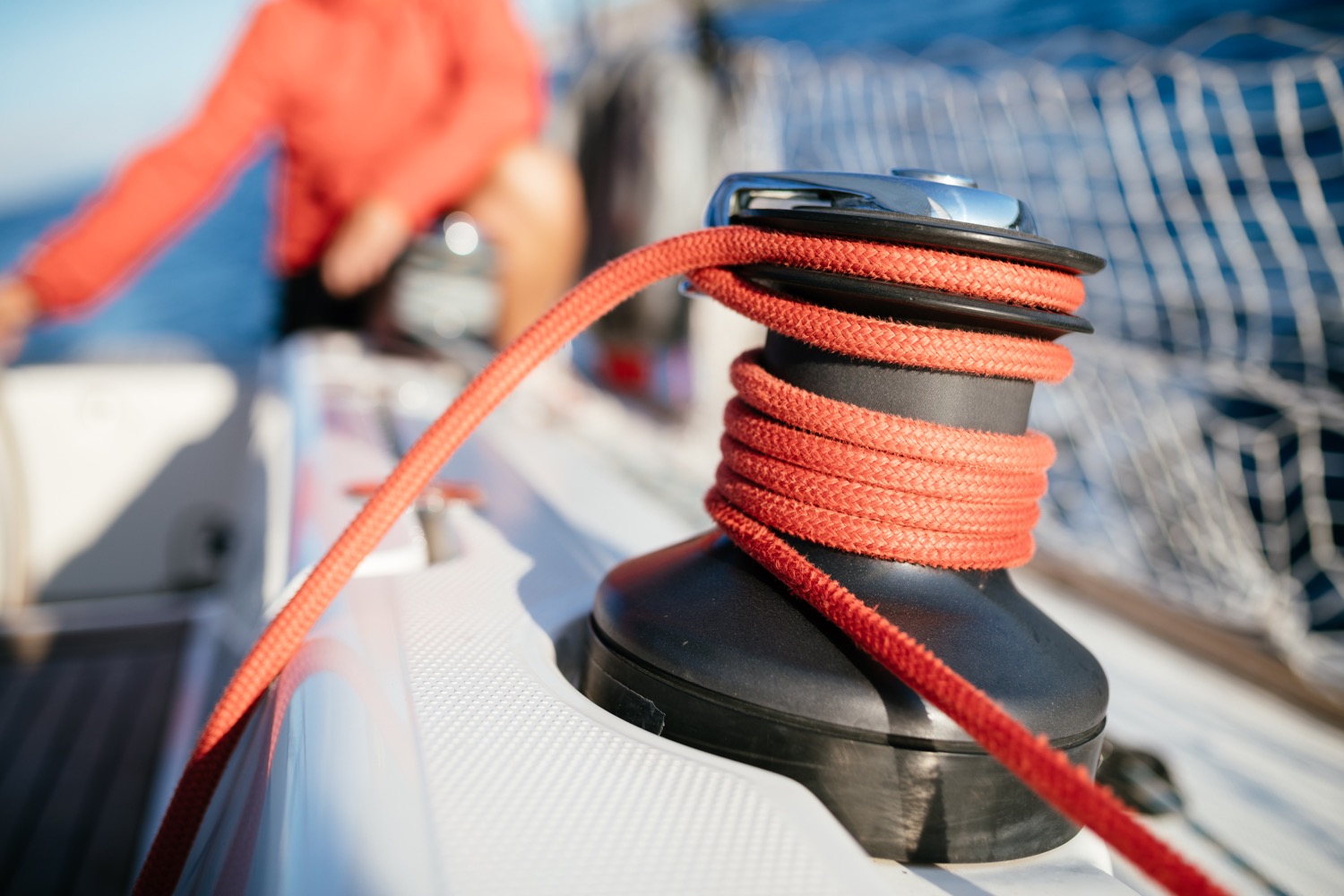
You'll find the compass typically in the cockpit. It's the most old-skool navigation tool out there, but I'm convinced it's also one of the most reliable. In any way, it definitely is the most solid backup navigator you can get for the money.
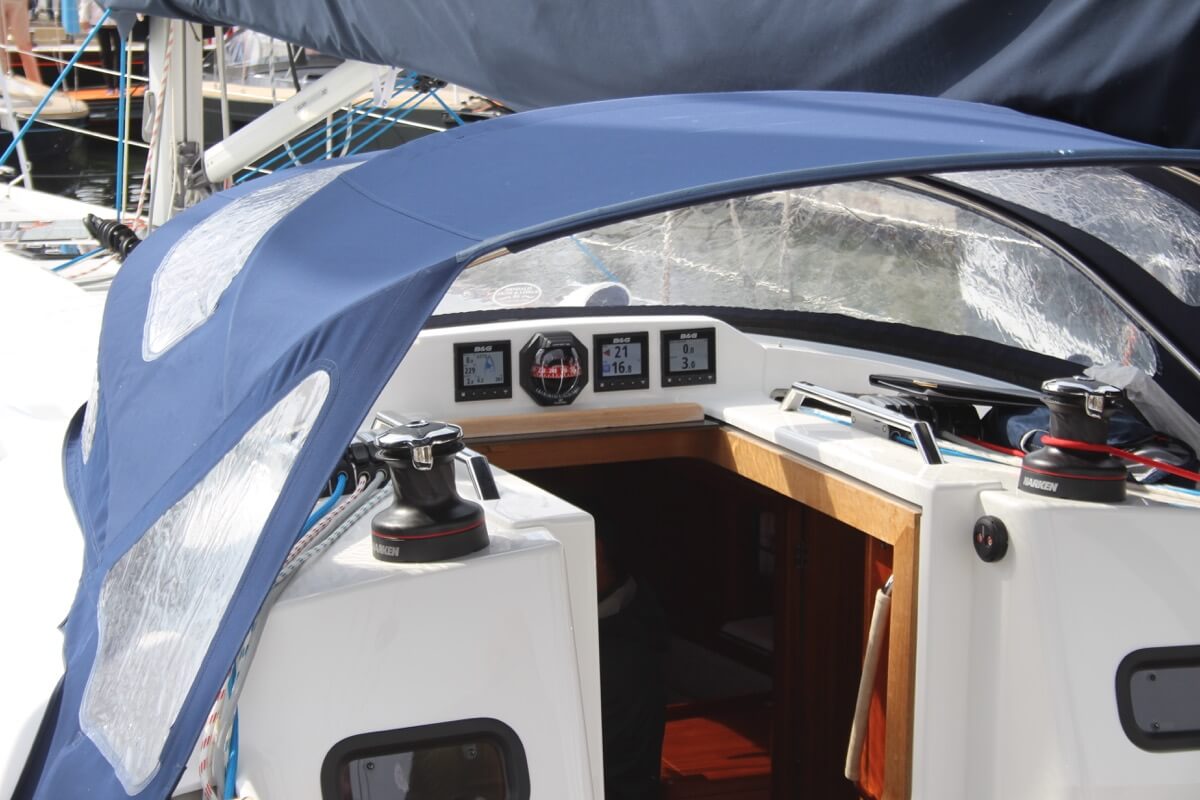
Want to learn how to use a compass quickly and reliably? It's easy. Just read my step-by-step beginner guide on How To Use a Compass (opens in new tab .
Chartplotter
Most sailboats nowadays use, besides a compass and a map, a chartplotter. Chartplotters are GPS devices that show a map and a course. It's very similar to your normal car navigation.
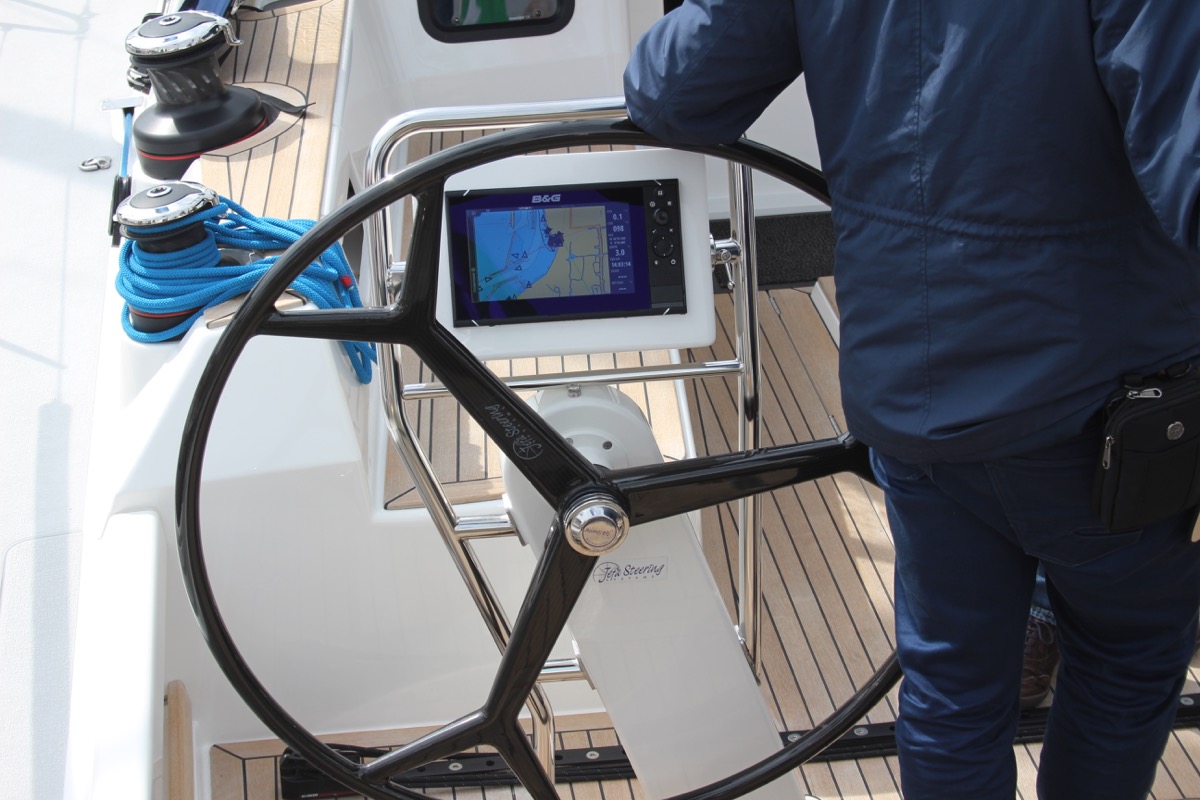
Outboard motor
Most sailboats have some sort of motor to help out when there's just the slightest breeze. These engines aren't very big or powerful, and most sailboats up to 32' use an outboard motor. You'll find these at the back of the boat.
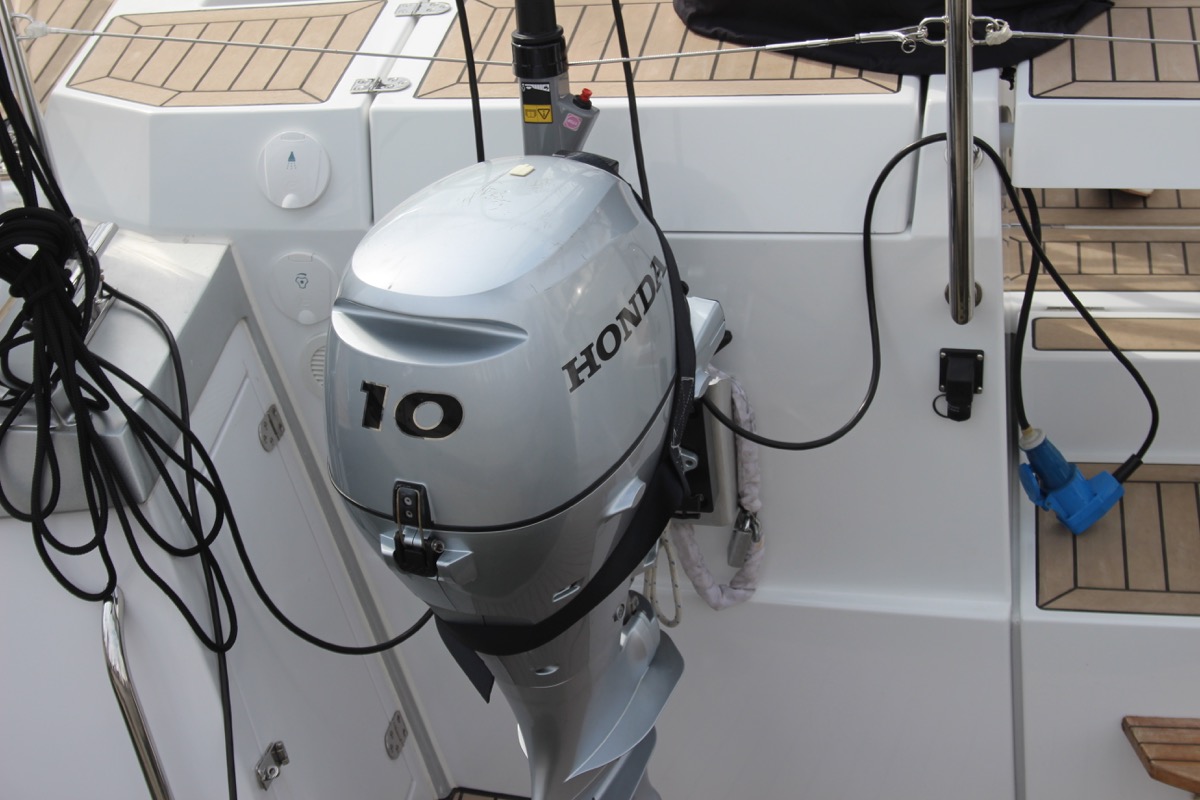
Most sailboats carry 1 - 3 anchors: one bow anchor (the main one) and two stern anchors. The last two are optional and are mostly used by bluewater cruisers.
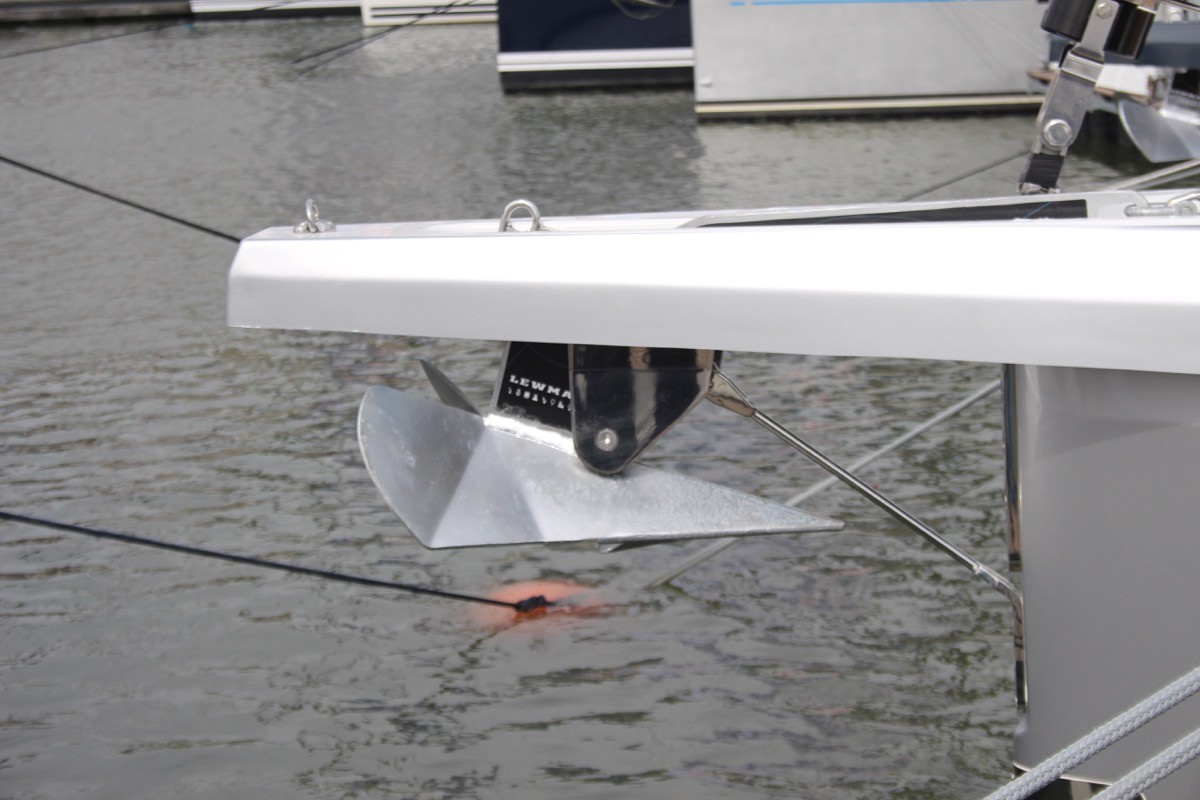
I hope this was helpful, and that you've gained a good understanding of the different parts involved in sailing. I wanted to write a good walk-through instead of overwhelming you with lists and lists of nautical terms. I hope I've succeeded. If so, I appreciate any comments and tips below.
I've tried to be as comprehensive as possible, without getting into the real nitty gritty. That would make for a gigantic article. However, if you feel I've left something out that really should be in here, please let me know in the comments below, so I can update the article.
I own a small 20 foot yacht called a Red witch made locally back in the 70s here in Western Australia i found your article great and enjoyed reading it i know it will be a great help for me in my future leaning to sail regards John.
David Gardner
İ think this is a good explanation of the difference between a ”rope” and a ”line”:
Rope is unemployed cordage. In other words, when it is in a coil and has not been assigned a job, it is just a rope.
On the other hand, when you prepare a rope for a specific task, it becomes employed and is a line. The line is labeled by the job it performs; for example, anchor line, dock line, fender line, etc.
Hey Mr. Buckles
I am taking on new crew to race with me on my Flying Scot (19ft dingy). I find your Sailboat Parts Explained to be clear and concise. I believe it will help my new crew learn the language that we use on the boat quickly without being overwhelmed.
PS: my grandparents were from Friesland and emigrated to America.
Thank you Shawn for the well written, clear and easy to digest introductory article. Just after reading this first article I feel excited and ready to set sails and go!! LOL!! Cheers! Daniel.
steve Balog
well done, chap
Great intro. However, the overview diagram misidentifies the cockpit location. The cockpit is located aft of the helm. Your diagram points to a location to the fore of the helm.
William Thompson-Ambrose
An excellent introduction to the basic anatomy and function of the sailboat. Anyone who wants to start sailing should consider the above article before stepping aboard! Thank-you
James Huskisson
Thanks for you efforts mate. We’ve all got to start somewhere. Thanks for sharing. Hoping to my first yacht. 25ft Holland. Would love to cross the Bass Strait one day to Tasmania. 👌 Cheers mate
Alan Alexander Percy
thankyou ijust aquired my first sailboat at 66yrs of age its down at pelican point a beautifull place in virginia usa my sailboat is a redwing 30 if you are ever in the area i wouldnt mind your guidance and superior knowledge of how to sail but iam sure your fantastic article will help my sailboat is wings 30 ft
Thanks for quick refresher course. Having sailed in California for 20+ years I now live in Spain where I have to take a spanish exam for a sailboat license. Problem is, it’s only in spanish. So a lot to learn for an old guy like me.
Very comprehensive, thank you
Your article really brought all the pieces together for me today. I have been adventuring my first sailing voyage for 2 months from the Carolinas and am now in Eleuthera waiting on weather to make the Exumas!!! Great job and thanks
Helen Ballard
I’ve at last found something of an adventure to have in sailing, so I’m starting at the basics, I have done a little sailing but need more despite being over 60 life in the old dog etc, thanks for your information 😊
Barbara Scott
I don’t have a sailboat, neither do l plan to literally take to the waters. But for mental exercise, l have decided to take to sailing in my Bermuda sloop, learning what it takes to become a good sailor and run a tight ship, even if it’s just imaginary. Thank you for helping me on my journey to countless adventures and misadventures, just to keep it out of the doldrums! (I’m a 69 year old African American female who have rediscovered why l enjoyed reading The Adventures of Robert Louis Stevenson as well as his captivating description of sea, wind, sailboat,and sailor).
Great article and very good information source for a beginner like me. But I didn’t find out what I had hoped to, which is, what are all those noisy bits of kit on top of the mast? I know the one with the arrow is a weather vane, but the rest? Many thanks, Jay.
Louis Cohen
The main halyard is attached to the head of the mainsail, not the to the mainsheet. In the USA, we say gaff, not gaffer. The gaff often has its own halyard separate from the main halyard.
Other than that it’s a nice article with good diagrams.
A Girl Who Has an Open Sail Dream
Wow! That was a lot of great detail! Thank you, this is going to help me a lot on my project!
Hi, good info, do u know a book that explains all the systems on a candc 27,
Emma Delaney
As a hobbyist, I was hesitant to invest in expensive CAD software, but CADHOBBY IntelliCAD has proven to be a cost-effective alternative that delivers the same quality and performance.
https://www.cadhobby.com/
Leave a comment
You may also like, guide to understanding sail rig types (with pictures).
There are a lot of different sail rig types and it can be difficult to remember what's what. So I've come up with a system. Let me explain it in this article.
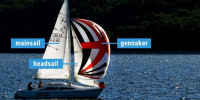
The Ultimate Guide to Sail Types and Rigs (with Pictures)
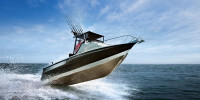
The Illustrated Guide To Boat Hull Types (11 Examples)
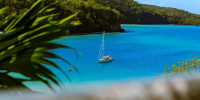
How To Live On a Boat For Free: How I'd Do It

How To Live on a Sailboat: Consider These 5 Things
Own your first boat within a year on any budget.
A sailboat doesn't have to be expensive if you know what you're doing. If you want to learn how to make your sailing dream reality within a year, leave your email and I'll send you free updates . I don't like spam - I will only send helpful content.
Ready to Own Your First Boat?
Just tell us the best email address to send your tips to:
- Types of Sailboats
- Parts of a Sailboat
- Cruising Boats
- Small Sailboats
- Design Basics
- Sailboats under 30'
- Sailboats 30'-35
- Sailboats 35'-40'
- Sailboats 40'-45'
- Sailboats 45'-50'
- Sailboats 50'-55'
- Sailboats over 55'
- Masts & Spars
- Knots, Bends & Hitches
- The 12v Energy Equation
- Electronics & Instrumentation
- Build Your Own Boat
- Buying a Used Boat
- Choosing Accessories
- Living on a Boat
- Cruising Offshore
- Sailing in the Caribbean
- Anchoring Skills
- Sailing Authors & Their Writings
- Mary's Journal
- Nautical Terms
- Cruising Sailboats for Sale
- List your Boat for Sale Here!
- Used Sailing Equipment for Sale
- Sell Your Unwanted Gear
- Sailing eBooks: Download them here!
- Your Sailboats
- Your Sailing Stories
- Your Fishing Stories
- Advertising
- What's New?
- Chartering a Sailboat
- Running Rigging
Sailboat Rigging: Part 2 - Running Rigging
Sailboat rigging can be described as being either running rigging which is adjustable and controls the sails - or standing rigging, which fixed and is there to support the mast. And there's a huge amount of it on the average cruising boat...

- Port and starboard sheets for the jib, plus two more for the staysail (in the case of a cutter rig) plus a halyard for each - that's 6 separate lines;
- In the case of a cutter you'll need port and starboard runners - that's 2 more;
- A jib furling line - 1 more;
- An up-haul, down-haul and a guy for the whisker pole - 3 more;
- A tackline, sheet and halyard for the cruising chute if you have one - another 3;
- A mainsheet, halyard, kicker, clew outhaul, topping lift and probably three reefing pennants for the mainsail (unless you have an in-mast or in-boom furling system) - 8 more.
Total? 23 separate lines for a cutter-rigged boat, 18 for a sloop. Either way, that's a lot of string for setting and trimming the sails.

Many skippers prefer to have all running rigging brought back to the cockpit - clearly a safer option than having to operate halyards and reefing lines at the mast. The downside is that the turning blocks at the mast cause friction and associated wear and tear on the lines.
The Essential Properties of Lines for Running Rigging
It's often under high load, so it needs to have a high tensile strength and minimal stretch.
It will run around blocks, be secured in jammers and self-tailing winches and be wrapped around cleats, so good chafe resistance is essential.
Finally it needs to be kind to the hands so a soft pliable line will be much more pleasant to use than a hard rough one.
Not all running rigging is highly stressed of course; lines for headsail roller reefing and mainsail furling systems are comparatively lightly loaded, as are mainsail jiffy reefing pennants, single-line reefing systems and lazy jacks .
But a fully cranked-up sail puts its halyard under enormous load. Any stretch in the halyard would allow the sail to sag and loose its shape.
It used to be that wire halyards with spliced-on rope tails to ease handling were the only way of providing the necessary stress/strain properties for halyards.
Thankfully those days are astern of us - running rigging has moved on a great deal in recent years, as have the winches, jammers and other hardware associated with it.
Modern Materials
Ropes made from modern hi-tech fibres such as Spectra or Dyneema are as strong as wire, lighter than polyester ropes and are virtually stretch free. It's only the core that is made from the hi-tech material; the outer covering is abrasion and UV resistant braided polyester.
But there are a few issues with them:~
- They don't like being bent through a tight radius. A bowline or any other knot will reduce their strength significantly;
- For the same reason, sheaves must have a diameter of at least eight times the diameter of the line;
- Splicing securely to shackles or other rigging hardware is difficult to achieve, as it's slippery stuff. Best to get these done by a professional rigger...
- As you may have guessed, it's expensive stuff!
My approach on Alacazam is to use Dyneema cored line for all applications that are under load for long periods of time - the jib halyard, staysail halyard, main halyard, spinnaker halyard, kicking strap and checkstays - and pre-stretched polyester braid-on-braid line for all other running rigging applications.
Approximate Line Diameters for Running Rigging
But note the word 'approximate'. More precise diameters can only be determined when additional data regarding line material, sail areas, boat type and safety factors are taken into consideration.
Length of boat
Spinnaker guys
Boom Vang and preventers
Spinnaker sheet
Genoa sheet
Main halyard
Genoa / Jib halyard
Spinnaker halyard
Pole uphaul
Pole downhaul
Reefing pennants
Lengthwise it will of course depend on the layout of the boat, the height of the mast and whether it's a fractional or masthead rig - and if you want to bring everything back to the cockpit...
Read more about Reefing and Sail Handling...

Headsail Roller Reefing Systems Can Jam If Not Set Up Correctly
When headsail roller reefing systems jam there's usually just one reason for it. This is what it is, and here's how to prevent it from happening...

Single Line Reefing; the Simplest Way to Pull a Slab in the Mainsail
Before going to the expense of installing an in-mast or in-boom mainsail roller reefing systems, you should take a look at the simple, dependable and inexpensive single line reefing system

Is Jiffy Reefing the simplest way to reef your boat's mainsail?
Nothing beats the jiffy reefing system for simplicity and reliability. It may have lost some of its popularity due to expensive in mast and in boom reefing systems, but it still works!
Recent Articles
'Cabo Frio', a Catalina Morgan 43 for sale
Apr 01, 24 08:35 AM
Live Aboard Boats For Sale
Mar 30, 24 07:02 PM
A Beneteau Oceanis 43 for Sale
Mar 30, 24 06:01 PM
Here's where to:
- Find Used Sailboats for Sale...
- Find Used Sailing Gear for Sale...
- List your Sailboat for Sale...
- List your Used Sailing Gear...
Our eBooks...

A few of our Most Popular Pages...

Copyright © 2024 Dick McClary Sailboat-Cruising.com

Boat Sailor
Halyard sailing: unlocking the secrets to smooth sailing.

Ahoy there, fellow sailing enthusiasts! Today, I’m excited to dive deep into the world of halyard sailing, a crucial aspect of sailing that often goes overlooked. As someone who has spent countless hours on the water, I can vouch for the significance of a well-maintained halyard system in optimizing your sailing experience. So, hop aboard as we hoist the sails and explore the ins and outs of halyard sailing!
Introduction to Halyard Sailing
As you embark on your sailing journey, understanding the fundamentals of halyards becomes paramount. These seemingly ordinary ropes play a pivotal role in raising and lowering sails, directly impacting your vessel’s performance and safety. But fear not, we’re here to guide you through the enchanting realm of halyard sailing!
Understanding Halyards
What are halyards.
Halyards are ropes or lines used to hoist and lower sails, allowing you to harness the wind’s power and set your course. These ropes are the unsung heroes that transform the still canvas into billowing sails, propelling your boat forward.
Types of Halyards
There are various halyards available, each catering to different sailing needs. From wire halyards to modern synthetic lines, understanding their unique characteristics empowers you to make informed choices.
Materials Used for Halyards
The choice of halyard material can significantly impact its strength, durability, and performance. We’ll explore the pros and cons of different materials, helping you decide what suits your sailing style best.
Importance of Proper Halyard Setup

Safety and Performance
A well-maintained halyard system ensures not only a smooth sailing experience but also enhances your safety on the water. We’ll delve into the relationship between halyards and safety, so you can navigate with confidence.
Avoiding Wear and Tear
Halyards are subject to wear over time due to constant use and exposure to the elements. By understanding how to minimize wear, you can prolong their lifespan and save on replacement costs.
Enhancing Sail Control
Efficient halyard handling allows for precise sail control, empowering you to adapt to changing weather conditions and achieve optimal performance. Let’s unravel the secrets of harnessing the wind’s full potential.
Choosing the Right Halyard for Your Sailboat

Consider the Boat Type
The type of boat you own plays a vital role in determining the appropriate halyard. Whether you’re cruising on a monohull or flying on a catamaran , we’ve got you covered.
Sailing Conditions
Adapting to varying weather conditions demands the right halyard choice. Discover how to match halyards to different wind strengths and sea states, ensuring a pleasurable sail in all circumstances.
Sail Material and Size
The type of sails you use influences the halyard’s requirements. We’ll explore the connection between sail material, size, and halyard selection to optimize your sailboat’s performance.
Maintaining and Inspecting Halyards
Regular cleaning and lubrication.
Proper halyard maintenance involves regular cleaning and lubrication to prevent dirt buildup and maintain smooth operation. Learn the best practices for keeping your halyards in top-notch condition.
Identifying Signs of Wear
Vigilance is key to spotting early signs of halyard wear. We’ll walk you through common indicators, ensuring you catch any issues before they escalate into a larger problem.
Replacing Halyards
When the time comes to bid farewell to your trusty halyards, having a seamless replacement process can get you back on the water swiftly. We’ll provide guidance on when and how to replace aging halyards.
Best Practices for Halyard Handling
Raising and lowering sails.
Mastering the art of raising and lowering sails ensures a safe and efficient sailing experience. Discover techniques to execute these maneuvers effortlessly.
Preventing Tangles and Snags
Tangled halyards can quickly turn a leisurely sail into a frustrating affair. Unravel the mysteries of tangle prevention and maintain a stress-free sailing journey.
Coiling and Storing Halyards
A well-coiled halyard is a sailor’s best friend. Learn how to coil and store halyards properly, preventing tangles and extending their lifespan.
Upgrading Halyard Systems
Modern halyard technologies.
The world of sailing continues to evolve, and halyard technology is no exception. Explore the latest innovations that can take your sailing experience to the next level.
Benefits of Upgrading
Upgrading your halyard system can be a game-changer, but understanding the benefits is crucial before making the investment. We’ll discuss the advantages that come with modernizing your halyards.
Cost-Effectiveness
Is upgrading halyards worth the investment? We’ll weigh the costs against the benefits, helping you make an informed decision based on your sailing needs.
Troubleshooting Halyard Issues
Empower yourself with DIY halyard fixes that can save you time and money. Discover quick and easy solutions to common halyard challenges.
When to Seek Professional Help
While some issues can be tackled on your own, others may require professional expertise. Know when it’s time to call in the experts for halyard-related matters.
Enhancing Performance with Halyard Tuning
Tuning for different conditions.
Adapting your halyard setup to different wind and sea conditions can optimize your boat’s performance. Learn how to fine-tune your halyards for any sailing scenario.
Improving Sail Shape
Halyard tension plays a vital role in achieving the desired sail shape. Unlock the secrets of sail shape optimization for maximum speed and efficiency.
Optimizing Speed and Efficiency
Halyard tuning directly affects your boat’s speed and overall efficiency.
Tips for Halyard Care and Longevity
Protecting halyards from uv damage.
UV rays can take a toll on halyard strength and integrity. Discover how to shield your halyards from the sun’s harmful effects.
Avoiding Overloading
Overloading halyards can lead to premature wear and failure. Learn how to distribute loads properly and ensure your halyards stand the test of time.
Storing Halyards Properly
Proper halyard storage during offseason is crucial for their longevity. We’ll guide you through the best practices for storing halyards when they’re not in use.
Frequently Asked Questions
What’s the lifespan of a typical halyard.
Halyard lifespan can vary depending on several factors, such as material, usage, and maintenance. Generally, a well-maintained halyard can last anywhere from 3 to 10 years. Regular inspections and timely replacements can prolong their lifespan.
Can I use a rope halyard for my large sailboat?
Using a rope halyard for a large sailboat is possible, but it’s crucial to choose the right type of rope and ensure it has adequate strength to handle the loads. Consider the sail’s size, boat type, and sailing conditions before making a decision.
How do I know if my halyards need replacement?
Signs of wear, such as fraying, discoloration, or stiffness, may indicate that it’s time to replace your halyards. Additionally, if you notice reduced performance or difficulty in raising or lowering sails, it’s best to inspect the halyards thoroughly and consider replacement.
Can I use the same halyard for different sails?
While it’s possible to use the same halyard for different sails, it may not always be ideal. Different sails often have unique requirements in terms of tension and halyard length. It’s recommended to have dedicated halyards for each sail to ensure optimal performance.
How often should I inspect my halyards?
Regular inspections are essential to catch any signs of wear or damage early on. It’s advisable to inspect your halyards before and after every sailing season, and also periodically throughout the sailing season, especially after experiencing rough weather conditions.

Michael Thompson
Embarking on a lifelong love affair with the sea, I found solace and exhilaration in the art of sailing. From navigating treacherous waters to harnessing the wind's untamed power, my passion has evolved into a mission to inspire others. Join me on a voyage of discovery as we explore the vast horizons of sailing's timeless allure.
More to Explore

Sailing Apparel: Essential Gear for Smooth Sailing

Sail Boat Trailers: Your Guide to Safe and Convenient Transportation

Sail Boat Decor: Enhancing Your Nautical Oasis

Currency: GBP
- Worldwide Delivery
Mooring Warps and Mooring Lines
- LIROS 3 Strand Polyester Mooring Warps
- LIROS Braided Dockline Mooring Warps
- LIROS Classic Mooring Warps
- LIROS Green Wave 3 Strand Mooring Warps
- LIROS Handy Elastic Mooring Warps
- LIROS Moorex12 Mooring Warps
- LIROS Octoplait Polyester Mooring Warps
- LIROS Polypropylene Floating Mooring Warps
- LIROS Super Yacht Mooring Polyester Docklines
- Marlow Blue Ocean Dockline
Mooring Accessories
- Mooring Cleats and Fairleads
- Mooring Compensators
- Mooring Shackles
- Mooring Swivels
Mooring Strops
- LIROS 3 Strand Nylon Mooring Strops
- LIROS Anchorplait Nylon Mooring Strops
- Small Boat and RIB Mooring Strops
Mooring Bridles
- V shape Mooring Bridles
- Y shape Mooring Bridles
Mooring Strops with chain centre section
- 3 Strand / Chain / 3 Strand
- Anchorplait / Chain / Anchorplait
Bonomi Mooring Cleats
- Majoni Fenders
- Polyform Norway Fenders
- Dock Fenders
- Fender Ropes and Accessories
- Ocean Inflatable Fenders
Mooring Buoys
Max power bow thrusters.
- Coastline Bow Thruster Accessories
50 metre / 100 metre Rates - Mooring
Mooring information.
- Mooring Warps Size Guide
- Mooring Lines - LIROS Recommended Diameters
- Mooring Rope Selection Guide
- Mooring Warp Length and Configuration Guide
- How to estimate the length of a single line Mooring Strop
- Mooring Ropes - Break Load Chart
- Mooring Compensator Advisory
- Rope Cockling Information
- Fender Size Guide
- Majoni Fender Guide
- Polyform Norway Fender Inflation Guide
Custom Build Instructions
- More Article and Guides >
Anchor Warps Spliced to Chain
- LIROS 3 Strand Nylon Spliced to Chain
- LIROS 3 Strand Polyester Spliced to Chain
- LIROS Anchorplait Nylon Spliced to Chain
- LIROS Octoplait Polyester Spliced to Chain
Anchor Warps
- Leaded Anchor Warp
- LIROS 3 Strand Nylon Anchor Warps
- LIROS 3 Strand Polyester Anchor Warps
- LIROS Anchorplait Nylon Anchor Warps
- LIROS Octoplait Polyester Anchor Warps
- Aluminium Anchors
- Galvanised Anchors
- Stainless Steel Anchors
Calibrated Anchor Chain
- Cromox G6 Stainless Steel Chain
- G4 Calibrated Stainless Steel Anchor Chain
- Lofrans Grade 40
- MF DAMS Grade 70
- MF Grade 40
- Titan Grade 43
Clearance Chain
Anchoring accessories.
- Anchor Connectors
- Anchor Trip Hooks and Rings
- Anchoring Shackles
- Bow Rollers and Fittings
- Chain and Anchor Stoppers
- Chain Links and Markers
50 / 100 metre Rates - Anchoring
Chain snubbers.
- Chain Hooks, Grabs and Grippers
- Chain Snubbing Bridles
- Chain Snubbing Strops
Drogue Warps and Bridles
- Lewmar Windlasses
- Lofrans Windlasses
- Maxwell Windlasses
- Quick Windlasses
Windlass Accessories
- Coastline Windlass Accessories
- Lewmar Windlass Accessories
- Lofrans Windlass Accessories
- Lofrans Windlass Replacement Parts
- Maxwell Windlass Accessories
- Quick Windlass Accessories
Anchoring Information
- How To Choose A Main Anchor
- Anchoring System Assessment
- Anchor Chain and Rope Size Guide
- The Jimmy Green Guide to the Best Anchor Ropes
- What Size Anchor Do I Need?
- Anchor Size Guides
- Anchor Rope Break Load and Chain Compatibility Chart
- How to Choose Your Anchor Chain
- How to Establish the Correct Anchor Chain Calibration?
- Calibrated Anchor Chain - General Information
- Calibrated Anchor Chain Quality Control
- Calibrated Chain - Break Load and Weight Guide
- Galvanising - Managing Performance and Endurance expectation
- Can Galvanised Steel be used with Stainless Steel?
- Windlass Selection Guide
- More Articles and Guides

Stainless Steel Wire Rigging and Wire Rope
- 1x19 Wire Rigging
- 7x19 Flexible Wire Rigging
- Compacted Strand Wire Rigging
- Insulated 1x19 Wire Backstays
Wire Rigging Fittings
- Swaged Terminals
- Swageless Terminals
- Turnbuckles / Rigging screws
- Turnbuckle Components
- Backstay Insulators
- Wire Terminals
Rigging Accessories
- Backing Plates
- Backstay Adjuster and Fittings
- Backstay Blocks
- Pins, Rings and Nuts
- Rigging Chafe Protection
Fibre Rigging
- DynIce Dux Fibre Rigging
- LIROS D-Pro Static Rigging
- LIROS D-Pro-XTR Fibre Rigging
- Marlow Excel D12 MAX 78 Rigging
- Marlow M-Rig Max Rigging
Fibre Rigging Fittings
- Bluewave Rope Terminals
- Colligo Marine Terminals
Dinghy Rigging
- Dinghy Rigging Fittings
- Fibre Dinghy Rigging
- Stainless Steel Dinghy Rigging
Wind Indicators
Guard wires, guardrails and guardrail webbing.
- Guard Rail Fittings
- Guard Rails in Fibre and Webbing
- Guard Wire Accessories
- Guard Wires
Furling Systems
- Anti-torsion Stays
- Headsail Reefing Furlers
- Straight Luff Furlers
- Top Down Furlers
Furling Accessories
- Continuous Furling Line Accessories
- Furling Line Accessories
50 / 100 metre Rates - Wire and Fibre
Standing rigging assistance.
- More Articles and Guides >
- Cruising Halyards
- Performance Halyards
- Dinghy Halyards
Rigging Shackles
- Bronze Snap Shackles
- Captive and Key Pin Shackles
- hamma™ Snap Shackles
- Selden Snap Shackles
- Soft Shackles
- Standard Snap Shackles
- Tylaska End Fittings
- Wichard Snap Shackles
Lashing, Lacing and Lanyards
- LIROS 3 Strand Lashing, Lacing and Lanyards
- LIROS Braided Lashing, Lacing and Lanyards
- Cruising Sheets
- Performance Sheets
- Dinghy Sheets
- Continuous Sheets
- Tapered Sheets
Running Rigging Accessories
- Anti-Chafe Rope Protection
- Barton Sail Handling
- Lazy Jack Sail Handling
- Rodkickers, Boomstruts
- Sail Handling Accessories
- Slab Reefing
Shock Cord and Fittings
Control lines.
- Cruising Control Lines
- Performance Control Lines
- Dinghy Control Lines
- Continuous Control Lines
Classic Ropes
- 50 / 100 metres - Classic
- Classic Control Lines
- Classic Docklines
- Classic Halyards
- Classic Sheets
- LIROS Classic 3 Strand Polyester
50 / 100 metre Rates - Running Rigging
- 50 / 100 metres - Cruising Ropes
- 50 / 100 metres - Dinghy Ropes
- 50 / 100 metres - Lashing and Lanyards
- 50 / 100 metres - Performance Ropes
- LIROS Ropes
- Marlow Ropes
Running Rigging Resources
- Running Rigging Rope Fibres and Construction Explained
- How to Select a Suitable Halyard Rope
- How to select Sheets and Guys
- Dyneema Rope - Cruising and Racing Comparison
- Dinghy Rope Selection Guide
- Rope Measurement Information
- Running Rigging - LIROS Recommended Line Diameters
- Running Rigging Break Load Comparison Chart
- Colour Coding for Running Rigging
- Selecting the right type of block, plain, roller or ball bearing
- Replacing your Furling Line
- Recycling Rope
- Running Rigging Glossary
Custom Build Instructions for Sheets, Halyards, Control Lines
Low friction rings, plain bearing blocks.
- Barton Blocks
- Harken Element Blocks
- Seasure 25mm Blocks
- Selden Yacht Blocks
Wooden Blocks
Ball bearing blocks.
- Barton Ball Bearing Blocks
- Harken Ball Bearing Blocks
- Holt Dynamic Blocks
- Selden Ball Bearing Blocks
Ratchet Blocks
- Harken Ratchet Blocks
- Selden Ratchet Blocks
Roller Bearing Blocks
- Harken Black Magic Blocks
- Selden Roller Bearing Blocks
Clutches and Organisers
- Barton Clutches and Organisers
- Lewmar Clutches
- Spinlock Clutches and Organisers
Genoa Car Systems
- Barton Genoa Sheeting
- Harken Genoa Systems
- Lewmar HTX Genoa Systems
Traveller Systems
- Barton Traveller Systems
- Harken Traveller Systems
Deck Fittings
- Bungs and Hatches
- Bushes and Fairleads
- Deck Eyes, Straps and Hooks
- Pad Eyes, U Bolts and Eye Bolts
Rudder and Transom Fittings
- Pintles and Gudgeons
- Tiller Extensions and Joints
Stanchion Blocks and Fairleads
Snatch blocks.
- Barton K Cam Cleats
- Harken Ball Bearing Cam Cleats
- Holt Cam Cleats
- Selden Cam Cleats
- Spinlock PXR Cleats
Block and Tackle Purchase Systems
- Barton Winches, Snubbers and Winchers
- Coastline Electric Winch Accessories
- Harken Winches, Handles and Accessories
- Karver Winches
- Lewmar Winches, Handles and Accessories
- Winch Servicing and Accessories
Deck Hardware Support
- Blocks and Pulleys Selection Guide
- Barton High Load Eyes
- Dyneema Low Friction Rings Comparison
- Seldén Block Selection Guide
- Barton Track Selection Guide
- Barton Traveller Systems Selection Guide
- Harken Winch Selection Guide
- Karver Winch Comparison Chart
- Lewmar Winch Selection Guide - PDF
- Winch Servicing Guide
Sailing Flags
- Courtesy Flags
- Red Ensigns
- Blue Ensigns
- Flag Accessories
- Flag Staffs and Sockets
- Flag Making and Repair
- Signal Code Flags
- Galvanised Shackles
- Stainless Steel Shackles
- Titanium Shackles
- Webbing only
- Webbing Restraint Straps
- Webbing Sail Ties
- Webbing Soft Shackles
Hatches and Portlights
Sail care and repair.
- Sail Sewing
Maintenance
- Antifouling
- Fillers and Sealants
- Primers and Thinners
- PROtect Tape
Fixings and Fastenings
- Monel Rivets
- Screws, Bolts, Nuts and Washers
- U Bolts, Eye Bolts and Pad Eyes
Splicing Accessories
- Fids and Tools
- Knives and Scissors
General Chandlery
- Barrier Ropes
- Canvas Bags and Accessories
- Carabiners and Hooks
- Netting and Accessories
- Rope Ladders
Seago Boats and Tenders
Chandlery information, flag articles.
- Flag Size Guide
- Bending and Hoisting Methods for Sailing Flags
- Courtesy Flags Identification, Labelling and Stowage
- Courtesy Flag Map
- Flag Etiquette and Information
- Glossary of Flag Terms and Parts of a Flag
- Making and Repairing Flags
- Signal Code Message Definitions
Other Chandlery Articles
- Anchorplait Splicing Instructions
- Antifoul Coverage Information
- Hawk Wind Indicator Selection Guide
- Petersen Stainless - Upset Forging Information
- Speedy Stitcher Sewing Instructions
- Thimble Dimensions and Compatible Shackles
Jackstays and Jacklines
- Webbing Jackstays
- Stainless Steel Wire Jackstay Lifelines
- Fibre Jackstay Lifelines
- Jackstay and Lifeline Accessories
Safety Lines
Lifejackets.
- Children's Life Jackets
- Crewsaver Lifejackets
- Seago Lifejackets
- Spinlock Lifejackets
Buoyancy Aids
Life jackets accessories.
- Lifejacket Lights
- Lifejacket Rearming Kits
- Lifejacket Spray Hoods
Overboard Recovery
- Lifebuoy Accessories
- Purchase Systems
- Slings and Throwlines
Floating Rope
- LIROS Multifilament White Polypropylene
- LIROS Yellow Floating Safety Rope
- Danbuoy Accessories
- Jimmy Green Danbuoys
- Jonbuoy Danbuoys
- Seago Danbuoys
- Liferaft Accessories
- Seago Liferafts
Safety Accessories
- Fire Safety
- Grab Bag Contents
- Grab Bags and Polybottles
- Handheld VHF Radios
- Sea Anchors and Drogues
Safety Resources
- Guard Wires - Inspection and Replacement Guidance
- Guard Wire Stud Terminal Dimensions
- Webbing Jackstays Guidance
- Webbing Jackstays - Custom Build Instructions
- Danbuoy Selection Guide
- Danbuoy Instructions - 3 piece Telescopic - Offshore
- Liferaft Selection Guide
- Liferaft Servicing
- Man Overboard Equipment - World Sailing Compliance
- Marine Safety Information Links
- Safety Marine Equipment List for UK Pleasure Vessels
Sailing Clothing
- Sailing Jackets
- Sailing Trousers
- Thermal Layers
Leisure Wear
- Accessories
- Rain Jackets
- Sweatshirts
Sailing Footwear
- Dinghy Boots and Shoes
- Sailing Wellies
Leisure Footwear
- Walking Shoes
Sailing Accessories
- Sailing Bags and Holdalls
- Sailing Gloves
- Sailing Kneepads
Clothing Clearance
Clothing guide.
- What to wear Sailing
- Helly Hansen Mens Jacket and Pant Size Guide
- Helly Hansen Womens Sailing Jacket and Pant Size Guide
- Lazy Jacks Mens and Womens Size Charts
- Musto Men's and Women's Size Charts
- Old Guys Rule Size Guide
- Sailing Gloves Size Guides
- Weird Fish Clothing Size Charts
The Jimmy Green Clothing Store
Lower Fore St, Beer, East Devon, EX12 3EG
- Adria Bandiere
- Anchor Marine
- Anchor Right
- August Race
- Barton Marine
- Blue Performance
- Brierley Lifting
- Brook International
- Brookes & Adams
- Captain Currey
- Chaineries Limousines
- Coastline Technology
- Colligo Marine
- Cyclops Marine
- Douglas Marine
- Ecoworks Marine
- Exposure OLAS
- Fire Safety Stick
- Fortress Marine Anchors
- Hawk Marine Products
- Helly Hansen
- International
- Jimmy Green Marine
- Maillon Rapide
- Mantus Marine
- Marling Leek
- Meridian Zero
- MF Catenificio
- Ocean Fenders
- Ocean Safety
- Old Guys Rule
- Petersen Stainless
- Polyform Norway
- PSP Marine Tape
- Sidermarine
- Stewart Manufacturing Inc
- Team McLube
- Technical Marine Supplies
- Titan Marine (CMP)
- Ultramarine
- Waterline Design
- William Hackett
Clearance August Race Boat Cleaning Kit £26.00
Clearance LIROS Racer Dyneema £55.08
Clearance Folding Stock Anchor £123.25
Clearance LIROS Herkules £0.00
Clearance Barton Size 0 Ball Bearing Blocks - 5mm £10.13
Clearance Marlow Blue Ocean® Doublebraid £18.48
Mooring Clearance
Anchoring clearance, standing rigging clearance, running rigging clearance, deck hardware clearance, chandlery clearance, safety clearance, sheets and halyards selection guide.
23 Nov 2018
A guide to choosing the right replacement running rigging lines
Purchasing replacement lines is often a straightforward process. Especially, if you're happy with the performance of the existing line and can identify what it is. The length can easily be specified by measuring an existing halyard or sheet and can even be guessed fairly accurately, from schematics if you are familiar with your deck layout. The nominal diameter is slightly trickier because different brands use different volumes of fibre to achieve their specifications creating slight variations in comparable ropes. If in doubt, deck hardware is often a good place to check for recommended line diameters.

The difficulty arises when considering an upgrade or you're not entirely sure what you already have on board. At this point, the material to be used, the construction and the diameter of the rope all need to be considered. These factors have a significant influence on the overall cost and performance of your line. This guide aims to help you choose the right line at the right price.
Rope Materials
There are many more fibres available for the truly discerning sailor, however, this article sets out the 5 most common ones found in our product range.
Listed in order from most expensive to most economical, they are Vectran, Dyneema, Technora, Polyester and Polypropylene.

- Vectran is the strongest and most expensive fibre and has very low elongation over time (creep). It is commonly impregnated with a UV stabiliser.
- Dyneema is very nearly equal to Vectran in terms of strength and stretch and is also usually impregnated with a UV protective coating. The price advantage over Vectran makes this a popular choice with rope manufacturers at the upper end of the market.
- Technora has very high abrasion and UV resistance and is commonly blended into the cover/jacket of a braid on braid line.
- Polyester is the most common fibre with excellent UV resistance, good breaking strains and low stretch characteristics. It is available in a bright monofilament fibre and a softer, matt finish, spun yarn. Bright polyester fibres are low stretch e.g. braid on braid bright white polyester. The softer feel, spun yarn has less strength and is slightly stretchier. Spun yarn is typically used for the cover/jacket on e.g. 16 plait matt polyester.
- Polypropylene is the lightest (doesn't absorb water) and cheapest fibre. However, it is stretchy and susceptible to UV.
Rope manufacturers have traditionally used different fibres for the core and the cover, in order to make the most of their relative advantages, but can now produce even better ropes by blending different fibres together, in either the core or the jacket.
Rope Construction

The majority of lines are comprised of a braided core and a braided jacket. The most common cruising lines are 100% polyester (cost effective). The weight of fibre in these lines is usually balanced equally between the cover and the core and can be spliced using the double braid splice.
Marlowbraid is the exception as it has a 3-strand core which slightly reduces stretch for a very modest increase in price. The downside of this construction is that it tends to flatten around sheaves and winches.

N.B. braided lines with a polypropylene core may make a saving but will be reflected in a marked lack of performance particularly with regard to extra stretch where it is not desirable.
The construction of the cover also has a bearing on abrasion resistance. Generally, the covers with a tighter weave or 'more plaits' e.g. 8, 16, 24 or 32 plaits offer a sliding scale of improved wear resistance.
Stronger fibres such as Dyneema or Vectran are required to significantly increase the strength of a line and reduce its stretch. Typically, these fibres are used in the core which is therefore much stronger than the cover. These lines then have to be spliced using the core dependent method which in turn means the weight of fibre in the cover can be reduced.
Cost vs Performance
The cost is directly related to the amount of Dyneema/Vectran content in the finished rope and therefore related to the strength and stretch.

It, therefore, follows that the strongest (and most expensive) line for a given diameter does not have a cover and is 100% 'core'. However, Halyards and sheets still rely on the cover for grip and abrasion resistance in clutches and on winches. The solution is to strip the cover from the core shortly after the winch or clutch. This can only be done with core dependent ropes.
All the fibres mentioned can be blended to produce covers with different properties. Racers may use a polypropylene/Dyneema blend for lightweight sheets or a technora/polyester blend for sheets that get through a lot of work. Cruisers are less likely to have sailing condition specific requirements, so a standard polyester cover heavy enough to give good longevity is usually the best bet.
Choose the right line
The full range of lines supplied by Jimmy Green Marine can cater for both the cruisers and the racers. So we have arranged the lines on a sliding scale to help you decide where to aim. Specifications are based on 12mm lines.
Whether you're a cruiser looking to strengthen up your lines for a more adventurous outing or a racer looking for a better price point Jimmy Green has a line for you.
You can also find further information on the infographic below. The stretch percentages are based on a 500kg working load rather than an ultimate breaking load. This accounts for the difference between the infographic and the table above.

Shop for Sheets and Halyards
Related products
Liros 12mm dynamic plus dyneema - sheets, halyards, control lines, 10mm marlowbraid - sheets, halyards, control lines, 100 metre reel - marlowbraid, liros 14mm herkules - sheets, halyards, control lines, 50 metre cut length - liros classic matt plait polyester, author: jimmy green, you may also like.

Top 5 Sail Control Ropes

Ten tips to help you enjoy winter sailing.
Keyboard_arrow_left guide to tackling a complete re-rig, the decision-making checklist for buying anchor chain keyboard_arrow_right.
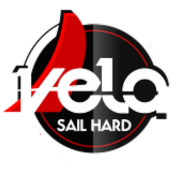
- Lines & Rigging
- Sailboat Running Rigging
- Lines by Application
Sailboat Halyard Lines

Samson Warpspeed II 1/2"

Samson Warpspeed II 7/16"

Samson Warpspeed II 3/8"

Yale Cordage Crystalyne 1/4"

Samson Warpspeed II 5/16"

Samson Warpspeed II 1/4"

Robline Orion 300

Marlow D2 Club
FREE SHIPPING ON ALL ORDERS OF $150, UNDER 50LBS

- Shop Products ▼
- Order Status
- Shipping Return
- Request Quote
- Rigging & Marine
RIGGING SUPPLY YOU CAN DEPEND ON
US Rigging Offers Halyards & Sailing Lines
Are you looking to replace some old rigging ropes on your boat? Did you just win the lottery and buy a new yacht? Need a mast rope? How about a flagpole rope? US Rigging has been manufacturing and distributing rigging materials for decades now. It probably goes without saying that we know a few things about ropes and sailing lines are no exception. We have provided some basic info on some things you may want to think about when shopping for a halyard.
Scroll down and see if we can teach you a thing or two about Halyards and Sailing Lines.
What Exactly Is A Halyard?
A halyard is a line that is used in sailing or boating for various functions. It may simply be a flagpole rope, or it could be used to raise sails or spars. These ropes often include polyester materials and are typically designed to give very low stretch or elongation.
Some Other Terms Used For Halyard:
- Sailing Line
What Are Some Factors To Consider In Choosing A Halyard?
Now that we have established what a halyard is, let’s break down a few things you will want to look out for when choosing your sailing line. When you are choosing a halyard, there are many different things you want to think about. In most cases, the most important features that you will be looking for are ropes that offer resistance to extreme abrasion. Aside from looking for a solid core, the additional covering can allow for more protection from wear. Often you will also want to look for ropes with higher diameters. If you are using a clutch, you will want to get pretty close to the maximum diameter of rope that the clutch will accept.
Here’s A Few General Rules:
- Halyards Should Almost Always Be Low Stretch
- Ropes With Increased Abrasion Resistance Are Ideal
- Sailing Lines Should Be Close To The Maximum Diameter A Clutch Will Accept
What Are Some Types Of Halyard Ropes For Sailboats?
After talking in general terms about some of the things you want to be looking for in your halyards, let’s talk a little about different types of lines that are available. US Rigging offers two general different types of sailing lines - Wire To Rope Lines and Spinnaker Lanyards.
Wire To Rope Lines are more generalized, multipurpose halyards. They are often used to replace old halyards on boats. The wire core offers a lower stretch in the rope, making it ideal for boating applications. The rope cover provides a softer grip which makes handling the line easier and more comfortable.
Spinnaker Halyards are designed for more specific applications where a spinnaker is going to be used. Spinnakers are a style of sale, which are also sometimes called chutes or kites. These sails balloon out when they fill up with wind.
Spinnaker Halyards
As mentioned above, a spinnaker is a type of sail that is used for “off wind” sailing. It is designed to balloon out in the wind. As one may assume, a Spinnaker Halyard is a line that is used specifically for rigging with a spinnaker sail.
Here Are Some Features Of Spinnaker Sailing Lines:
- High Strength
- Low Stretch/Elongation
- Double Braided Polyester Cover
- Resistant To Water, Mold, And Mildew
- Tough Core Made Of High Tech Dacron Polyethylene
- Include A Stainless Steel Swivel Shackle And Snaphook
Wire To Rope Halyards
Wire To Rope Halyards is used as general-purpose lines in boating. They offer very low stretch with their core made of Dacron Polyethylene Materials and are hand-spliced to maintain rope strength.
Here Are Some Features Of Wire To Rope Halyards:
- Highly Flexible
- Includes A Stainless Steel Thimble
- Hand Spliced To Maintain Rope Strength
- Commonly Use To Replace Old Halyards
Who Is US Rigging?
US Rigging is a manufacturer and master distributor of climbing ropes, fall protection equipment, and industrial rigging equipment located in Santa Ana, California. This Orange County-based company is proud to provide American Made products with both safety and service in mind. US Rigging has a legacy lasting over 40 years and is known for its operational excellence.
US Rigging offers a select variety of halyards and sailing lines designed specifically for boating applications. These include both halyards designed specifically for spinnakers and more generally use wire to rope sailing lines. These low stretch, high strength ropes are made with high tech Dacron polyethylene materials to ensure lines are tougher than they need to be.
Take a look around the product lines available and feel free to contact our customer service department with any questions. US Rigging is committed to excellence in service and providing our customers with the best rigging products on the market.
There are no products listed under this category.
FREQUENTLY ASKED QUESTIONS

Rope Types For Sailors (AKA Sailing Line)

Last Updated by
Capt Chris German
June 15, 2022
Ask any sailor, “What’s this rope used for,” and they will promptly correct you and tell you in the most condescending voice they can muster, “it's a line.”
There are no ropes on a sailboat. A rope is a line without a purpose. The second it is cut off the bolt it becomes a line regardless of its type or function. So before we say another word about “rope” let’s get our verbiage straight - its a line.
Now that we have that figured out, the question of which line is good for which application and which line is best for sailing becomes clear as mud.
The truth is, a novice sailor can step on a dinghy and become overwhelmed by the number and types of lines used to make a sailboat move.
And that is exactly what they do. They make a boat move.
Without a halyard, the main would flop lifelessly to the deck. Without a jib sheet, the jib would flail wildly on the forestay.
But lines on a sailboat go so much farther than sheets and halyards, and in some cases it can get so complicated that one must label each block and cleat with color coded stickers so as to not get confused.
A worn out, frayed line can make the prettiest of sailboats look like a hoopty. Lines should be crisp and bright and give a boat pop and function.
Shoddy lines and worse yet, shoddy line handling, can expose a weekend warrior from a seasoned salt without so much as uttering a word.
Table of contents
There are no ropes on a sailboat. A rope is a line without a purpose. The second it is cut off the bolt it becomes a line regardless of its type or function. So before we say another word about “rope” let’s get our verbiage straight- its a line.
The Flemish Flake
While one’s mind immediately flashes to big colorful spinnakers and pristine white sails set on an azure blue sea, some of the most important lines for any boat, but the most important for a sailboat, are dock lines.
They come in three flavors, “three-strand”, “braided” and polypropylene, though you prove yourself to be a true dolt if anyone catches you using a polypropylene line on your sailboat.
The Polypropylene is the goto for tow boats and wake boarders alike, because it is low stretch, floats and is cheap to buy.
Most sailboaters would rather be caught dead than use a polyline on their boat, but some of the best floating mooring pennants are made of poly and they are decidedly not cheap at all. But for our purposes, let's focus on three strand and braided.
Three Strand
Three strand is the standard for anchoring or docking because it stretches quite well or more to the point it “bounces”. The three strands give it the ability to stretch as much as 60% of its length before breaking and because of that it is a good shock absorber to tie to non-pliable objects like the dock and the ground.
Braided Line
Braided line is also very common for dock lines and it gets its strength from the fact that it has many strands all braided together. I prefer three-strand to braided for the simple fact that even fumbling DIYers like me can weave a sturdy eye splice into three-strand. Braided line is spliceable but requires a much more committed approach to splicing and unusually must be spliced by machine, something that is beyond me.
But whether you are a braided guy or a three strand girl, here's the one thing that will show you to be a tourist in the boating world before you ever get to say a word. “The Flemish flake.”
Go down any dock in America and you will see at least one flemish flake neatly spun into a coil at the foot of someone’s boat. The truth is, it is entirely gauche and quite frankly bad for the line. Unless your line is flaked neatly on top of a spic and span newly varnished deck sitting in the middle of the Annapolis Sailboat Show, it shouldn’t be flemish flaked.
The line will not dry out and all too often leaves stains wherever it is flaked. Whether on your foredeck or your dock, it acquires dirt and regardless of how bad it is for your line, it is also bad form. So don’t do it.
Is it really just a line?
Lines and line work put sailboats into a higher echelon than working boats or power boats. They are very functional when sailing, but they also are the thing that makes your eye jump and your mind get mentally erect when looking at a pretty vessel. Even a landlubber who has never seen a main unfurled can walk down a dock and say, “my that’s a pretty sailboat” I would argue like properly accessorised bling on a young ladies neck, so to do lines adorn a pretty boat.
Lines, neatly coiled, hanging authoritatively from the mast or boom have always made my heart flutter and that was before I ever knew the difference between an outhaul and a cunningham. The many colors they come in, the different sizes and the many uses make the boat seem like a high tech Christmas tree to the untrained eye. But once you know what each and every line does on a boat, I assure, it gets even better.
There are two functions for lines on a sailboat, halyards and sheets. Halyards raise and lower sails while sheets haul them in and trim them for navigational purposes. These two functions are universal from the tiny little Opti to the USS Constitution. All sailboats, regardless of size, have sheets and halyards. But for our purposes let us stop there with one main halyard and one jib halyard. One main sheet and one jib sheet.
If you bought a sailboat from a manufacturer, they will likely have already picked out the right size and color lines for your boat, but if you buy a second hand version, you will likely have to buy new ones at some point. They should be different colors to avoid confusion, blue fleck for the main halyard, green fleck for the jib sheets , blue with white fleck for the mainsheet and white with green fleck for the jib sheets. But you can get whatever you like. You just have to make sure it jives with mast blocks, jam cleats and any other tackle you might have on your boat. The big thing is to get lines that feel good in your hand. Skinny lines can chaffe a tender paw in seconds and a bigger line, while more expensive, is worth it when you are beating your way to windward and have to make a sail change.
But oh that is where the lines just begin. Outhauls and downhauls, roller furlers and reefing lines. Topsail lifts and boom stays. There are literally hundreds of kinds of lines you can have on a sailboat and that doesn’t even include the spinnaker gear. And they all cost lots of money because they are sailing lines. That means they are low stretch and designed by professionals to pull on stuff in a really cool way and look good doing it.
If you want to check out all the options that are out there, go to New England Ropes and shop their website. They literally have every kind of line you could need for your boat from dock lines to spectra and would be more than happy to sell you a whole bunch of it.
The GoodWill of Sailing
If you want to put diamonds on your best girl, then who am I to judge. But just in case your sailboat is more of the cubic zirconia type of girl, there are options.
Used lines are to be found everywhere. Dumpster diving at the yacht club or bin digging at the boat consignment shop. Many a great deal can be found by digging through old garage sails by the sea and you never know what you can find. Old dock lines, used halyards even the odd semi consumed bolt of spectra has been found by the industrious yard saler sailors.
But if dumpster diving isn’t your thing, there is always the internet. Ebay, Amazon and other online marketplaces have tons of used lines and line remnants for sail. Just make sure that the line you are buying is the same size and will replace the length you need replaced. You can also get all kinds of blocks, tackle and other boat parts, but lines can be really expensive so save what you can where you can, right?
How do I care for the line?
Lines get dirty, salty, sandy, moldy and otherwise very yucky. Every season you should make it your policy to clean your lines thoroughly with lots of fresh water and a very gentle soap like “Dawn”.
Just like your sails, (if you missed that article check it out here) , you should never put anything on your lines that you would not put on your child’s hands. Bleach, harsh marine chemicals and solvents can break down the lines and make them brittle and melted.
Also let them dry in the sun after you wash them and never stow a wet line below decks. It’ll mold in a matter of hours.
And speaking of melted, if you notice the bitter end of your lines coming loose or fraying, get on that immediately to save the rest of your line. I like to wrap the end with duct tape, (the crazier the color the better so everyone knows it's your line) and melt the end with a line gun or a lighter. This works on braided, three strand and spectra and if you catch it quick you can save the line. But once it starts to unravel, it’s like putting ketchup back in the bottle. You could also use liquid whipping to finish the end of your line or use an actual whipping line and sail palm to finish your ends. Whatever you choose to do, just make sure that your ends are tight. Spectra loses its sheathing and exposes its coring very easily and three strand unravels just as bad.
How to replace a halyard
If you do decide to replace your lines, halyards can be quite a challenge. I hate heights and while I have climbed my mast to fix a flown halyard, it is not very fun. It gets even harder when you have an internal halyard in your mast or a boat that is a bit too small to climb. This yet another application where a sail palm can be helpful.
Put your old halyard end to end with your new halyard. Take a sailing needle and 3 feet of whipping line and sew the two ends together a few times with loops though the bitter end of each line a few times. Then tighten those loops with a half dozen wraps and tie the line off. That should hold the two lines together so you can pull the new halyard through the mast head without it breaking apart and you flying the halyard.
Another strategy you can try that doesn’t involve dropping the mast or climbing it with a bosun's chair, is moving your boat to a dock or bridge that is high enough where you can tip the boat and reach the mast. In my home town we had the benefit of a six foot tide and some really high docks at the low tide. I used to bring my fleet of idea 18s and my other small keelboats into the dock at low tide to do masthead work on them because there was no way I was going to let my well-fed carcass get hauled up those masts. We had to wait for a low tide and a calm morning, (this was hell to pull off on a choppy afternoon with boat traffic), but a quick tip of the boat was a ton easier than dropping the mast for a skied halyard.
And one more note on wire line splices. For a period there in the last century it was all the rage to use wire line spliced halyards on keel boats . The idea was that if you had wire, it wouldn’t stretch and would keep you sails tighter for racing conditions. The problem with them is as they got older, the rope part got dry rotted and cruddy and the wire frayed into fish hooks that could rip right through a sailing glove. The new spectra has made wire line splices a thing of the past, but if you have an older boat and still have wire line splices you really should consider changing them out. Odds are you will have to change the sheaves in the blocks of your mast head but that's a lot better than taking a fish hook to the palm of your hand or unexpectedly dropping the mainsail.
So that’s a wrap (a line joke). Lines can be a thing of beauty or a pain in the neck. Keep them clean and make sure you dry them thoroughly before stowing them or (God forbid) flemish flaking them on your boat. There are lots of options if you can’t afford to buy a full suit of brand news lines for your favorite lady, but there are great deals to be found online and at tag sales. The good folks at New England Ropes can talk you through most of your line questions and I would recommend chatting with your local sailing retailer if you are thinking about investing in some new lines. And please, never forget, a rope has no purpose, but a new line can dress up the ugliest of old boats. Thanks for reading and remember, do good, have fun and sail far.
Related Articles
Capt Chris German is a life long sailor and licensed captain who has taught thousands to sail over the last 20 years. In 2007, he founded a US Sailing-based community sailing school in Bridgeport, CT for inner city youth and families. When Hurricane Sandy forced him to abandon those efforts, he moved to North Carolina where he set out to share this love for broadcasting and sailing with a growing web-based television audience through The Charted Life Television Network.
by this author
Sailboat Parts

Most Recent

What Does "Sailing By The Lee" Mean?
Daniel Wade
October 3, 2023

The Best Sailing Schools And Programs: Reviews & Ratings
September 26, 2023
Important Legal Info
Lifeofsailing.com is a participant in the Amazon Services LLC Associates Program, an affiliate advertising program designed to provide a means for sites to earn advertising fees by advertising and linking to Amazon. This site also participates in other affiliate programs and is compensated for referring traffic and business to these companies.
Similar Posts

How To Choose The Right Sailing Instructor
August 16, 2023

Cost To Sail Around The World
May 16, 2023

Small Sailboat Sizes: A Complete Guide
October 30, 2022
Popular Posts

Best Liveaboard Catamaran Sailboats
December 28, 2023

Can a Novice Sail Around the World?
Elizabeth O'Malley

4 Best Electric Outboard Motors

How Long Did It Take The Vikings To Sail To England?

10 Best Sailboat Brands (And Why)
December 20, 2023

7 Best Places To Liveaboard A Sailboat
Get the best sailing content.
Top Rated Posts
Lifeofsailing.com is a participant in the Amazon Services LLC Associates Program, an affiliate advertising program designed to provide a means for sites to earn advertising fees by advertising and linking to Amazon. This site also participates in other affiliate programs and is compensated for referring traffic and business to these companies. (866) 342-SAIL
© 2024 Life of Sailing Email: [email protected] Address: 11816 Inwood Rd #3024 Dallas, TX 75244 Disclaimer Privacy Policy
- New Sailboats
- Sailboats 21-30ft
- Sailboats 31-35ft
- Sailboats 36-40ft
- Sailboats Over 40ft
- Sailboats Under 21feet
- used_sailboats
- Apps and Computer Programs
- Communications
- Fishfinders
- Handheld Electronics
- Plotters MFDS Rradar
- Wind, Speed & Depth Instruments
- Anchoring Mooring
- Running Rigging
- Sails Canvas
- Standing Rigging
- Diesel Engines
- Off Grid Energy
- Cleaning Waxing
- DIY Projects
- Repair, Tools & Materials
- Spare Parts
- Tools & Gadgets
- Cabin Comfort
- Ventilation
- Footwear Apparel
- Foul Weather Gear
- Mailport & PS Advisor
- Inside Practical Sailor Blog
- Activate My Web Access
- Reset Password
- Customer Service

- Free Newsletter

Ericson 34-2 Finds Sweet Spot
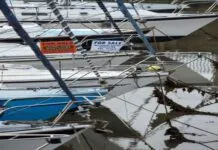
How to Sell Your Boat

Cal 2-46: A Venerable Lapworth Design Brought Up to Date
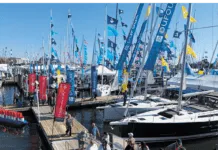
Rhumb Lines: Show Highlights from Annapolis
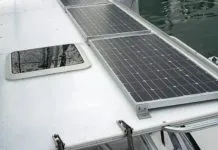
Solar Panels: Go Rigid If You have the Space…
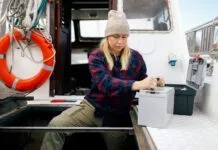
Leaping Into Lithium
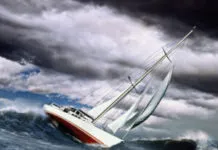
The Importance of Sea State in Weather Planning
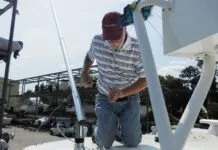
Do-it-yourself Electrical System Survey and Inspection

When Should We Retire Dyneema Stays and Running Rigging?
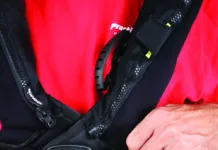
Rethinking MOB Prevention

Top-notch Wind Indicators
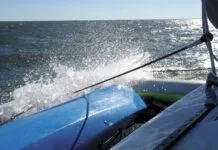
The Everlasting Multihull Trampoline

What Your Boat and the Baltimore Super Container Ship May Have…
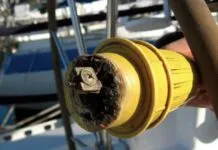
Check Your Shorepower System for Hidden Dangers
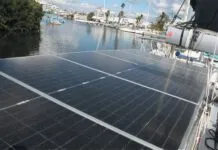
DIY survey of boat solar and wind turbine systems

What’s Involved in Setting Up a Lithium Battery System?
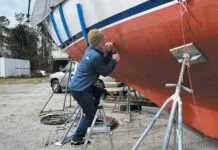
The Scraper-only Approach to Bottom Paint Removal
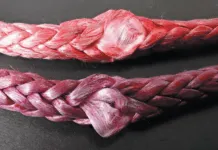
Can You Recoat Dyneema?
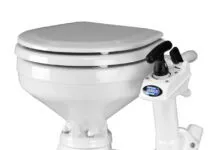
How to Handle the Head
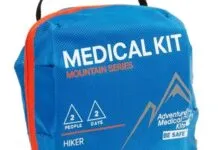
The Day Sailor’s First-Aid Kit
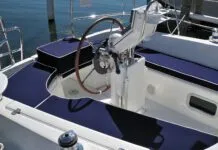
Choosing and Securing Seat Cushions

Cockpit Drains on Race Boats
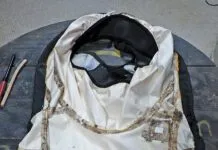
Re-sealing the Seams on Waterproof Fabrics
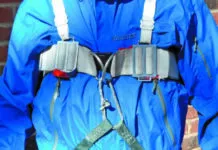
Safer Sailing: Add Leg Loops to Your Harness
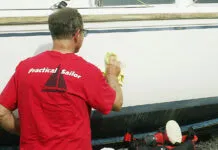
Waxing and Polishing Your Boat
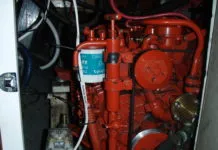
Reducing Engine Room Noise
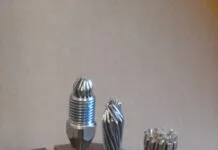
Tricks and Tips to Forming Do-it-yourself Rigging Terminals
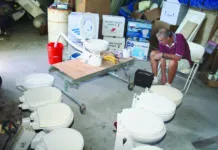
Marine Toilet Maintenance Tips

Learning to Live with Plastic Boat Bits
- Sails, Rigging & Deck Gear
Line Stowage Bags and Hooks
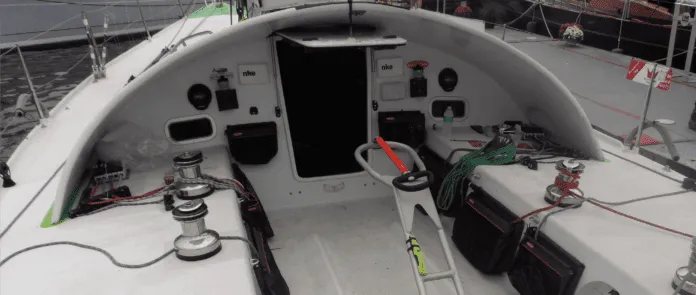
Sailboat cockpits will happily collect spaghetti if we let them, each sheet, halyard, and new control line adding to the confusion. The chaos is not just unsightly, it is inefficient, which is why race boats have a bag or hook for every line. Other than neatly flaking a lazy sheet in the corner or throwing halyard tails down the companionway (fast for racers), there are four basic options: coil and hang over a winch, secure the coil with a choker and hang over a hook, hang the coil from a hook that includes a captive line, or use a sheet and halyard bag. We use all four.
WHAT WE TESTED
We’ve had hooks on the boats for decades and have never broken one that was properly mounted. We’ve used bags on the foredeck, where a hook would not be sufficiently secure. We’ve even tied seldom-used lines to the deck using a pad eye with a captive tie cord. We’ve been adding controls and tweaks to our F-24. The original owner’s hooks have fallen off, and the clutter in the cockpit and lockers has gotten out of hand, so we decided to add a few new hooks and take inventory of our past experiences, including both hooks and sheet bags. See “ Sailboat Accessory Hooks ,” PS June 2019, for results of our strength testing. We have had glued-on hooks come off many times, including practically every previous owner effort.
HANG FROM A WINCH
Coiling line and hanging on a winch looks neat at the dock, but it really only works for the line primarily used on that winch. Jib sheets hang from primaries, reacher or spinnaker sheets from secondaries. Since you will often remove and flake these as soon as you board, the main purpose is to get them off the seats and reduce mildew. Any other line will have to be removed before sailing. If you have a row of jammers in front of the winch you will need something for the other lines.
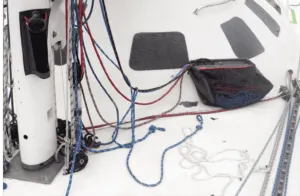
Lines can also be coiled and hung from the lifelines. While this is fine at dock, they swing around underway and are often out of reach. This is rarely a useful option on a multihull.
HANG FROM A HOOK
You can easily coil the line securely and luggage-tie a 1-foot bight around the coil and hang it from a hook. We like this method for lockers, because once secured, the coil can be handled freely and stowed or recovered from deep in a locker with one hand. Multiple coils can hang from a single hook. In fact, we designed a special recurved hook just for this purpose. It is secure in the most violent weather and will not snag or damage sails, other ropes, or clothing. It keeps the rope from piling up on the locker floor. But we are not fond of hooks on deck, because sooner or later they will snag something they shouldn’t.
COIL AND HANG FROM CAPTIVE LOOP
To hang a rope from a captive loop hanger, pass the loop through the center of the coiled rope and around the coils, and park the loop on the hook. We much prefer “hooks” that are have clips or covers so that they can’t snag other lines.
You have to remove some captive loop hangers to replace the line. Inside a locker, a bungee cord can last for decades, but in the sun, two years is a full life. This means any holes securing these hangers should be well sealed against any water intrusion, or you will surely introduce a leak which can damage core ( www.practical-sailor.com/blog/rotten-to-the-core ). Bungee gives the illusion of greater security than cord, but it does not last and is a little harder to work with, often requiring two hands. Ideally, the hook-hanger should be one that makes it easy to adjust the cord length to fit the coil.
RONSTAN SHOCK CORD LINE HANGER
We’ve used Ronstan hangers in lockers, and they have proven quite strong. We’re not fans of screw-on fasteners, the hook can snag other lines, and it must be removed to adjust or replace the cord. Still, they are durable and versatile. $9 for two.
SCHAEFER HANDIE HANGER
Instead of a hook, the Handie Hanger features a cord with the ball on the end, which drops into a slot. The cord is easily adjusted or replaced without removing the mounting block, and the design is virtually snag proof. The only downside is the requirement for screw-in fasteners, although a rail clamp is included. $19 for two.
POLIGLOW UNIVERSAL STAINLESS STEEL HANGER
This is similar to the Handie Hook, but in stainless. We examined this in a previous review, See “ Universal Hanger , PS November 2005). It’s specifically designed for rail mount. $9 for one.
BUTTON-LINE HOLDER, UNITED YACHT MANUFACTURING
This device’s very low profile makes it almost impossible to snag anything. A large area of high-bond, self-adhesive tape makes them permanent without drilling a hole. The captive line can be adjusted or replaced in minutes without removing the mount. You just poke the line from below up to access the stopper knot. They also make a small size, but because the surface area is smaller, it requires a fastener. (You can also put a screw through the large Button Holder, but there is no need). $6.75 each.
SOFT SHACKLES, KNOTTED STROPS, OR LOOPS WITH TOGGLES
Secured by eye straps or a mounting board, soft shackles are strong, cheap, robust, and pretty easy to work with. They will work well in an easy-to-reach locker. We have used loops with toggles to secure seldom-used reefing lines to the deck near the mast.
We’ve seen home-made racks consisting of a row of slots in a thin board, similar to the Handie Hanger. Mounted on spacers, the board stands off from the bulkhead. A short rope or shock cord with knots in each end, is used to secure the lines. Simply slide the knots into the slot, as with the Poliglow Universal hanger (see https://eoceanic.com/sailing/tips/11/84/an_easy_retainer_to_stow_warps_and_lines_and_have_them_ready_to_hand/
SHEET AND HALYARD BAGS
Bags are handy for lines that are used frequently, because the line does not have to be uncoiled and flaked before use. Bags are also good for lines that are very seldom used (halyards for furling sails). Lines dry more slowly than coils hanging in the air and are slightly more prone to mildew.
Fiberglass boxes are pretty, smoother, and the lines play out faster, but they are hard to lean against, and the lines dry more slowly, promoting mildew. The open mouths give better access and are nice on multihulls, but the more closed mouth of a canvas bag is more secure when waves roll across the deck or in a knockdown. Canvas bags with closing mouths or zippers are required near the mast and any area on deck that can be washed by waves.
If the line is long and used frequently a separate bag is best; long lines can tangle around each other and you may have to pull it all out and flake it for a for a fast release anyway (see “ Stopping Mainsheet Twist ,” PS June 2022). Short tails from control lines can share a bag. A single large bag can, of course, be divided.
Do you need a separate bag (or compartment) for each tail, or can they share? In our experience, sharing is fine for shorter lines that don’t have to run out fast, such as reefing tails, mainsail outhauls, and less used tweaks, but sheets and halyards are better separated.
BLUE PERFORMANCE MAST SHEET BAG
Our PDQ test boat had four halyards, three reefs, and a topping lift. We keep the reefs, furling genoa halyard, and topping lift tails coiled and securely lashed to the deck since they are not frequently used. However, the main and spinnaker halyard tails needed a safe home.
The Blue Performance Mast Sheet Bag (really more of a halyard bag) has been serving well for 6 years. Other than a little fading, performance has been faultless. The straps are easy to adjust and have remained secure. The bottom of our bag rests on the deck; if it were on the mast one of the straps would need a stop to prevent sliding downwards.
The zipper required lubrication after five years, but has been fine for a year since. The Velcro tabs on the flaps are holding up well, and none of the stitching is worn. The medium size bag easily holds the genoa halyard tail (55’ x ½” line) and topping lift tail (10’ x 3/8” line), leaving room in the top for a convenient winch handle. These are available in small ($54, 5.9” x 4.3” x 17.7”), medium ($64, 6.9” x 5.1 x 23.6”), and large ($74, 8” x 5.9” x 27.6”).
DIY SHEET BAGS
You can sew simple bags from Sunbrella or trampoline mesh, and they will last long. Add polyethylene (thin cutting board) stiffeners into the lip seam to hold it open. If you would like to test a bag’s utility in a certain location before investing a lot of time and money, get a cheap closet shoe bag, cut it into sections, and mount these with Velcro. They won’t last, but they will help you to buy or sew just what you need.
You can sew the bags directly to multihull tramps, or attach them with lines. We’ve used these bags on our tramps for halyard tails, downhauls, and anchoring bridles. We added these to our Stiletto tramp, and when it was due for replacement, the canvas maker integrated them into the design.
Rigid, or semi-rigid bins can also be fabricated from plywood, fiberglass, or a combination. We’ve seen several sailors repurpose a water jerry can for stowing a stern anchor rode. You simply cutout the spout, leaving a hole big enough for the rode. Unlike a bucket or crate, it has a flatter shape and lashes neatly to the sternrail.
At this year’s Annapolis Boat Show we noticed that proper sheet storage was sorely overlooked on nearly all cruising boats, with only the racers taking it seriously. We think we can learn from them.
On our F-24 and Yankee 30 test boats, we use a variety of methods, each selected for its best use. We like our DIY hooks in lockers for coils and gear secure with chokers. We can load a lot on them securely. We like the United Yacht Manufacturing Button Line Holders (captive loop) for quick one-handed storage of frequently used lines in the cockpit, or in places where bag won’t fit. We like sheet bags anywhere they fit, for long tails, and on deck where waves and spray are an issue. We still throw halyard tails down the companionway when day sailing. We’ve eliminated most of the spaghetti and we don’t miss the tripping and tangles.
SCHAEFER, www.schaefermarine.com
RONSTAN, www.ronstan.com
POLIGLOW, www.poliglow.com
UNITED YACHT MANUFACTURING, www.unitedyachting.com
VALUE GUIDE: LINE HANGERS
Sheetbags are not an instant cure for cockpit spaghetti. Stuffing several long tails into one large bag can actually promote tangling rather than prevent it. Hooks are handy, but can snag lines—not a problem inside lockers.
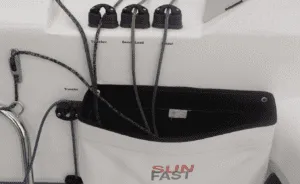
1. Multiple tails dumping into one back will work fine if the tails are short. Otherwise, a spaghetti soup will ensue.
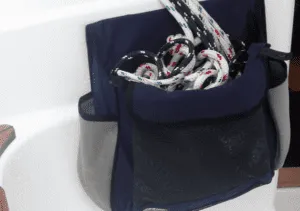
2. This bag reduces the clutter, but pulling a line out may result in a worse mess. Lines left in a bag will tend to grow mildew more readily than those that are aired out when the boat is idle.
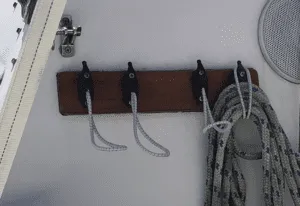
3. Ronstan hooks are strong, but they tend to snag lines in the cockpit and you have to remove them to replace the shock cord.
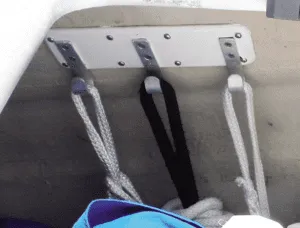
4. DIY hooks mounted on an aluminum strip provide a modular rack of hooks that can be removed. Turned inward, the hooks are strong and snag-resistant.
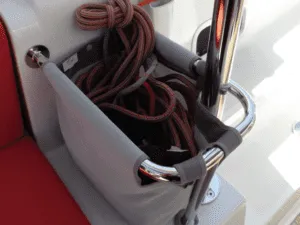
5. A stainless steel and fabric bin on this catamaran provides a semi-permanent place for sheets.
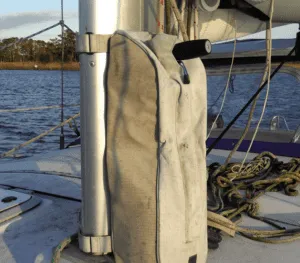
6. The Blue Performance bag keeps halyards (and winch handle) at the mast. Reefing lines are secured to deck padeyes by loops with toggles.
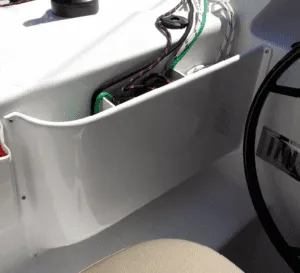
7. The sheet box on this Seawind catamaran has handy dividers.
Inexpensive, easy to install and service, stick-on button and line hangers proved to be an easy, affordable, and durable option for organizing lines. Ours have gone through several seasons without cracking or fading.
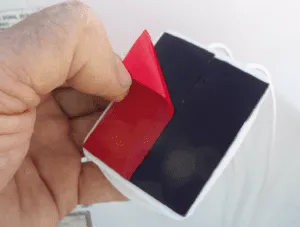
1. The high-strength peel-and-stick tape has held through rain, cold, freezing winters and hot summers.
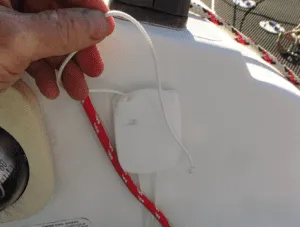
2. The supporting line is easily replaced or adjusted with out having to remove the button. The line can be released with one hand.
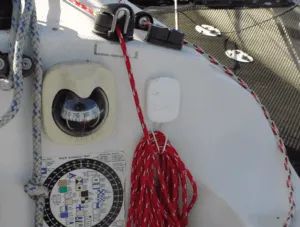
3. The buttons have a clean look and are unobtrusive in the cockpit. Here it secures a reacher furling-line tail.
RELATED ARTICLES MORE FROM AUTHOR
“Reefing lines are secured to deck padeyes by loops with toggles.” How so? Is the reefing line a separate line not attached to the sail clew reef cringles on the sail? – Thanks – Dennis
LEAVE A REPLY Cancel reply
Log in to leave a comment
Latest Videos
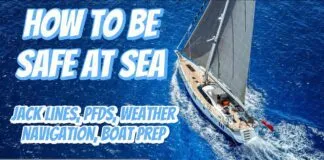
Safety At Sea For You & Your Family – The Joe...

What’s The Best Vinyl Window Cleaner for Your Boat?

40-Footer Boat Tours – With Some Big Surprises! | Boat Tour

Electrical Do’s and Don’ts
- Privacy Policy
- Do Not Sell My Personal Information
- Online Account Activation
- Privacy Manager
× You are using an outdated browser. Please upgrade your browser to improve your experience.
We Ship Worldwide! | FREE SHIPPING! for US Continental orders over $99. Click for details.

Shopping Cart
Your cart is currently empty..
FREE SHIPPING! for US Continental orders over $99 click for details
Sailing Lines & Ropes

We at MAURIPRO Sailing are fully committed to be your Halyards, Sheets and Sailboat Lines specialist not only providing the sailing community with a comprehensive and easy to use web site, but also with all the appropriate technical information that you might need to select your sailboat equipment. If you need any assistance selecting the appropriate Halyards, Sheets and Sailboat Lines for your boat please contact us. Our crew is ready to help!
MAURIPRO Sailing, your direct access to Sailing Lines & Ropes and all your other sailing and boating needs.
Copyright © 2024 MAURIPRO Sailing LLC.
Aft : The rear of a boat, close to the stern Backstay : A mast support that runs from the top of the mast to the stern of the boat. It may be adjustable in order to bend the mast backward or to increase tension on the forestay tool Ballast : Weight in the keel of a boat that adds stability Beam : A boat's greatest width Beating : Sailing (or pointing) at an angle into the wind or upwind. Since sailboats cannot sail directly into the wind, "beating" is the closest course to the wind they can sail. Bilge : The lowest part of a boat's hull
Blanketing : A tactical maneuver in which one boat slows a competitor by positioning itself to obstruct the competitor's wind Block : An assemblage of one or more sheaves (pulleys) housed in a plastic or metal case that changes the direction of travel of a line (rope) and may be attached to a boat's deck, spar or other stationary object Boom : Spar to which a sail's lower edge or foot is attached. The boom is attached to the mast at the gooseneck. Boom vang : Lines that control the boom. These lines run from the boom to the base of the mast and are used when reaching and running. Bow : The front of the boat Broach : When in a downwind situation, the boat turns uncontrollably and is pushed by the wind onto its side, lying with the mast parallel to the water. As a rule, the boat will right itself. Buoy : A floating marker Cam cleat : A mechanical cleat used to hold a line automatically. It uses two spring-loaded cams that come together to clamp their teeth on the line, which is placed between them. Also known as jam cleat . Centerboard : Like a keel, it is a weighted appendage projecting below the boat that keeps it from capsizing and also supplies the hydrodynamic lateral force that enables the boat to sail upwind. Unlike a keel, it is retractable. Cleat : A fitting, typically with projecting ends, that holds a line against the tension from the sails, rigging or mooring Clew : The lower corner of a mainsail or jib and either lower corner of a spinnaker Coming about : Turning the boat so the bow crosses through the eye of the wind, thereby changing the side of the yacht on which the sails are carried. Also known as tacking. Covering : A tactical maneuver in which a boat stays between a competitor and the wind or the next mark Daggerboard : An adjustable fin primarily used to stop the boat moving sideways through the water. Also known as centerboard. Dinghy : The Laser, Laser Radial, 470, and Finn are all dinghies that have been used in Olympic sailing - they all have one hull and a centreboard or daggerboard Downwind : The point of sail when the wind blows from aft of the boat's beam Drag : The negative or retarding force acting on a body, such as a boat moving through a fluid parallel and opposite to the direction of motion Fall off : A maneuver in which a boat turns away from the wind Fleet racing: Competition format were entries race against each other around a course Foot : The bottom edge of a sail Genoa/Headsail/Jib : The smaller sail set in front of the mast Gooseneck : A fitting that attaches the boom to the mast Gybe : Turning the boat so the stern crosses through the eye of the wind, (thereby changing the side of the boat on which the sails are carried (opposite of tacking). Also spelled jibe. Halyard : A line used to hoist and hold up a sail Header : Wind shift that causes the boat to head away from the mark Helmsman : The crew member who steers the boat; also the skipper, or the "driver" Hiking out : Leaning out of the craft in order to change the center of gravity in the boat and go faster Hiking straps : Straps attached to the feet that help a sailor hike out more, minimizing the chance of falling out of the boat Hull: The main body or shell of a ship or other vessel, including the bottom, sides, and deck ISAF : International Sailing Federation, the world governing body of sailboat racing Jam cleat : A device used to grip a line (rope). It has two rows of V-shaped molded teeth that grip the line when it is jammed in the groove. Also known as cam cleat. Jib : A foresail that overlaps the shroud base and is used for sailing upwind Jibe : Same as the gybe -- turning the boat so the stern crosses through the eye of the wind, thereby changing the side of the yacht on which the sails are carried (opposite of tacking) Kee l: A weighted, non-moveable appendage projecting below the boat that keeps it from capsizing and also supplies the hydrodynamic lateral force that enables the boat to sail upwind Kite : Large, light ballooning sails that are only attached to the mast at the corners. They are used when sailing downwind. Also known as spinnaker . Knot : One nautical mile per hour Lay : To sail a course that clears an object or racecourse marker buoy such as the windward and leeward marks. When a boat is doing so, it is said to be "laying the mark." Layline : An imaginary line projecting at an angle and corresponding to the wind direction from either side of a racecourse marker buoy that defines the optimum sailing angle for a boat to fetch the mark or the finish line. When a boat reaches this point, it is said to be "on the layline." Going beyond the layline means the boat is sailing a greater distance to reach the mark or finish line. Leech : The trailing edge of a sail or the curve of a sail Leeward : The side furthest away from the wind Lines : A nautical term for ropes Luff, to : Bubbling or flapping of a sail when it is not trimmed enough or is being back winded by another sailor when the course sailed is too close to the wind Mainsail : The sail behind the mast Mark : A buoy used in a racecourse Mast : The vertical spar that holds up the sails Match racing : A racing format in which only two boats compete at a time, as opposed to fleet racing, wherein three or more boats sail at once Medal race : The final race in the series. Only the top-10 boats after the opening series compete and scores are doubled. Multihull : Nacra 17 (boat used in its inaugural event at the 2016 Rio Olympic Games) - A boat with more than one hull. A boat with two hulls is also known as a catamaran and a boat with three hulls is knows as a trimaran. Nautical mile : The unit of geographical distance used on saltwater charts; one nautical mile equals 6,076 feet or 1.15 statute miles. Therefore, one statute mile equals 0.87 of a nautical mile. Off the wind : Sailing away from the wind; also downwind, reaching or running Plane : A boat planes when it sails over her own bow wave so only a small section of the hull is in the water. This allows the boat to go faster than the theoretical maximum hull speed. Pointing : Sailing at an angle into the wind or upwind. Depending on a boat's design, some will "point higher" or sail more directly into the wind and thus sail a shorter course to a given mark on the racecourse. Port : Nautical term for the left side of a boat when facing forward Port tack : Sailing with the wind blowing onto the port side and the mainsail on the starboard side Race officials : The officials responsible for running the race and enforcing the rules. This group includes the measurers who ensure that each sailor's equipment is equal and within the rules, the race officers who run the races and the judges and umpires who are rules experts and make decisions about whether rules have been broken. Reef : To decrease a sail's size Rigging : The wires, lines, halyards and other items used to attach the sails and the spars to the boat. The lines that do not have to be adjusted often are known as standing rigging. The lines that are adjusted to raise, lower and trim the sails are known as running rigging. Rudder : A moveable fin located underneath the back of the boat that steers the craft Running rigging : All moving rods and lines that support and control the mast and sails Shackle : A metal connector that attaches to other fittings with the use of a pin that is inserted through the arms of a U Sheet : A line that controls sails Skiff : 49er - A light open dinghy with a self-draining hull Slalom finish : A technical section of the windsurfing (RS:X) course involving multiple changes of direction in quick succession Spar : A basic term for a mast, boom or yard Spinnaker : Large, light ballooning sails that are only attached to the spars at the corners. They are used when running or reaching, sailing downwind. Starboard : Nautical term for the right half of the boat when facing forward Starboard tack : Sailing with the wind blowing onto the starboard side and the mainsail on the port side Stern : The rear of the boat Tacking : Turning the boat so the bow crosses through the eye of the wind, thereby changing the side of the boat on which the sails are carried (opposite of gybing) Tiller : A lever used to turn the rudder of a boat from side to side Trapeze : To stand on the side of the boat to maximize the effect of the body weight Trim : To adjust the sail to the right shape and angle to the wind. The process of "hiking out," or changing the center of gravity of the boat in order to go faster. Upwind : Toward the direction from which the wind blows; windward. Way : Forward motion of a boat. A term typically used in the context of saying that a boat is making way, is underway, or has way on. Windward : The side closest to the wind
Note: Some components of NBCOlympics.com may not be optimized for users browsing with Internet Explorer 11, 10 or older browsers or systems.

IMAGES
VIDEO
COMMENTS
Marine grade lines for sailboat main halyards, jib halyards, and spinnaker halyards. For advice on selecting the right halyard, see the information at the bottom of this page. A halyard line is the rope that pulls the sail up the mast. On some small sailboats, this might be a short 20 foot length of basic 5mm line.
You should also consider the halyard's stretch, which affects sail shape and performance. It is essential to choose a halyard that matches the load the sail will have on the line. Low-stretch halyards are ideal for racing and performance sailing, where every fraction of a knot counts. Some Things to Consider when Choosing a Halyard or Sheet ...
Our sailboat rigging include mainsail halyards, spinnaker halyards, and Genoa halyards that are made from a double braid polyester line, double braid Dyneema line or Vectran. Our mainsheets are also made from durable double braid polyester and hybrid fibers with blend of Dyneema and Technora. This material has the best reputation in the ...
Sailboat Halyard Lines. Full range of halyards made out of the latest on halyard lines with all needed splicing and required shackles (when applicable). MAURIPRO Sailing, your direct access to Sailboat Halyard Lines and all your other sailing and boating needs. Shop a full range of sailboat Halyard Lines at MAURIPRO Sailing Store. Includes ...
Lines made of polyester, Dyneema, Spectra, Technora, or Vectran are commonly used for sailboat halyards. Polyester lines offer good all-around performance and affordability. High-performance fibers like Dyneema, Spectra, Technora, and Vectran provide excellent strength, low stretch, and increased performance, albeit at a higher cost.
Common sizing: 8mm and 10mm for most small and midsize cruisers and club racers, 12mm for large sailboats. Dyneema Core lines: The way to go for racing halyards. Common names: New England Endurabraid and Samson Warpspeed. Our default set up is to tapper (remove the cover) to almost the whole height of the mast (with the sail up), leaving around ...
101: Everything about Halyards & Sheets. Running rigging is more than just ropes; it is about how much they help you achieve your sailing objectives. Therefore, we should pay special attention to the lines' quality and ensure they will have the perfect balance between performance and endurance. A perfect condition halyard will prevent the sail ...
In sailboat jargon, we call ropes 'lines'. But there are some lines with a specific function that have a different name. I think this makes it easier to communicate with your crew: you don't have to define which line you mean. Instead, you simply shout 'mainsheet!'. ... Halyards-'Halyard' is simply the nautical name for lines or ropes that are ...
But a fully cranked-up sail puts its halyard under enormous load. Any stretch in the halyard would allow the sail to sag and loose its shape. ... More precise diameters can only be determined when additional data regarding line material, sail areas, boat type and safety factors are taken into consideration. Length of boat. 6m (20ft) 8m (26ft ...
Available in 6 options. In Stock. 1-45 results of 90. 1. 2. Fisheries Supply is your premier supplier of sailing and rigging rope from top brands like Samson, Marlow, Robline and New England Rope. We offer a full range of sailing lines to replace any or all the running rigging on your boat such as halyards, sailboat sheets or control lines.
What are Halyards? Halyards are ropes or lines used to hoist and lower sails, allowing you to harness the wind's power and set your course. These ropes are the unsung heroes that transform the still canvas into billowing sails, propelling your boat forward. Types of Halyards. There are various halyards available, each catering to different ...
Ultimately, for the sake of a hundred dollars saved on a halyard, the owner never sees the full performance he paid for in his new sail. For an average boat in the mid-30-foot range, a new mainsail can cost from $2,000 upward, and the premium for a "performance" mainsail over a basic Dacron model starts at about $500.
Sheets and Halyard Selection Chart. You can also find further information on the infographic below. The stretch percentages are based on a 500kg working load rather than an ultimate breaking load. This accounts for the difference between the infographic and the table above. Shop for Sheets and Halyards.
Sailboat Halyard Running Rigging Ropes. FREE SHIPPING* US Continental (min order $98) International (min order $750)
MAURIPRO Rigging - Halyards. Full range of halyards made out of the latest on halyard lines with all needed splicing and required shackles (when applicable). MAURIPRO Sailing rigging shop division has created an easy to use set of tools to facilitate sailboat owners to find the correct length and specifications for your halyards. Need help?
A halyard is a line that is used in sailing or boating for various functions. It may simply be a flagpole rope, or it could be used to raise sails or spars. These ropes often include polyester materials and are typically designed to give very low stretch or elongation. Some Other Terms Used For Halyard:
http://www.sailrite.com/Replacing-your-Halyard-Rope-Video This video illustrates how to change your halyard rope in your sailboat. Did you know that rope hal...
Put your old halyard end to end with your new halyard. Take a sailing needle and 3 feet of whipping line and sew the two ends together a few times with loops though the bitter end of each line a few times. Then tighten those loops with a half dozen wraps and tie the line off.
Published: December 13, 2022. 1. Ronstan sheet bags maintain order on this Open 50 racing sailboat. Mesh allows lines to breathe and drain easily. Sailboat cockpits will happily collect spaghetti if we let them, each sheet, halyard, and new control line adding to the confusion. The chaos is not just unsightly, it is inefficient, which is why ...
Sailing Lines & Ropes. We at MAURIPRO Sailing are fully committed to be your Halyards, Sheets and Sailboat Lines specialist not only providing the sailing community with a comprehensive and easy to use web site, but also with all the appropriate technical information that you might need to select your sailboat equipment.
Gybe: Turning the boat so the stern crosses through the eye of the wind, (thereby changing the side of the boat on which the sails are carried (opposite of tacking). Also spelled jibe. Halyard: A line used to hoist and hold up a sail Header: Wind shift that causes the boat to head away from the mark